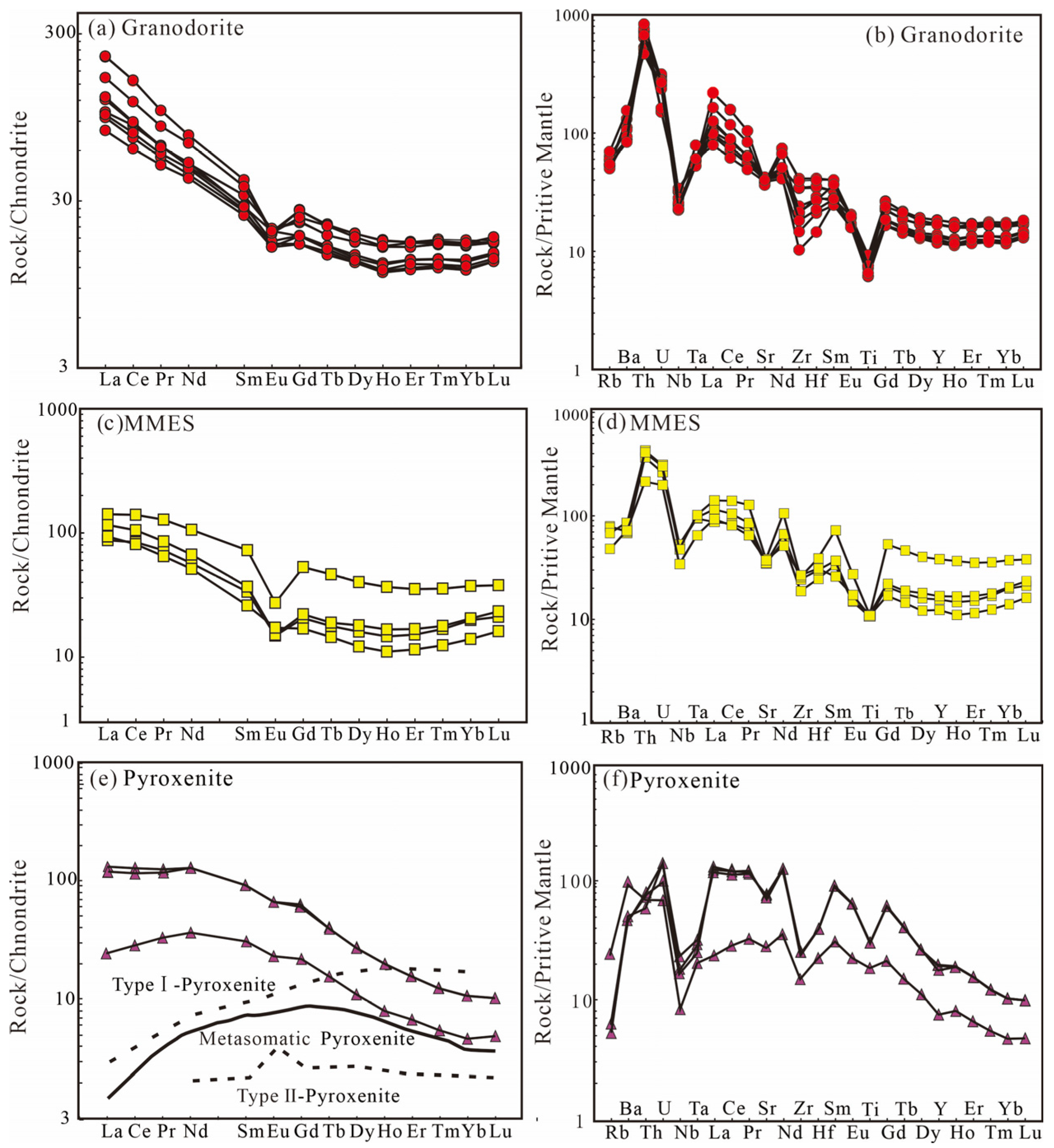Genesis of Early Cretaceous Magmatism in the Western Gangdese Belt, Southern Tibet: Implications for Neo-Tethyan Oceanic Slab Subduction
Abstract
1. Introduction
2. Regional Geology
3. Petrographic Characteristics
4. Analytical Methods
4.1. Isotope Geochronology
4.2. Whole-Rock Major and Trace Element Analysis
4.3. Zircon Lu-Hf Isotope
4.4. Whole-Rock Sr-Nd Isotopes
4.5. Mineral Major Elements Analysis
5. Results
5.1. Zircon U-Pb Geochronology
5.2. Whole-Rock Geochemistry
5.2.1. Whole-Rock Oxides and Trace Elements
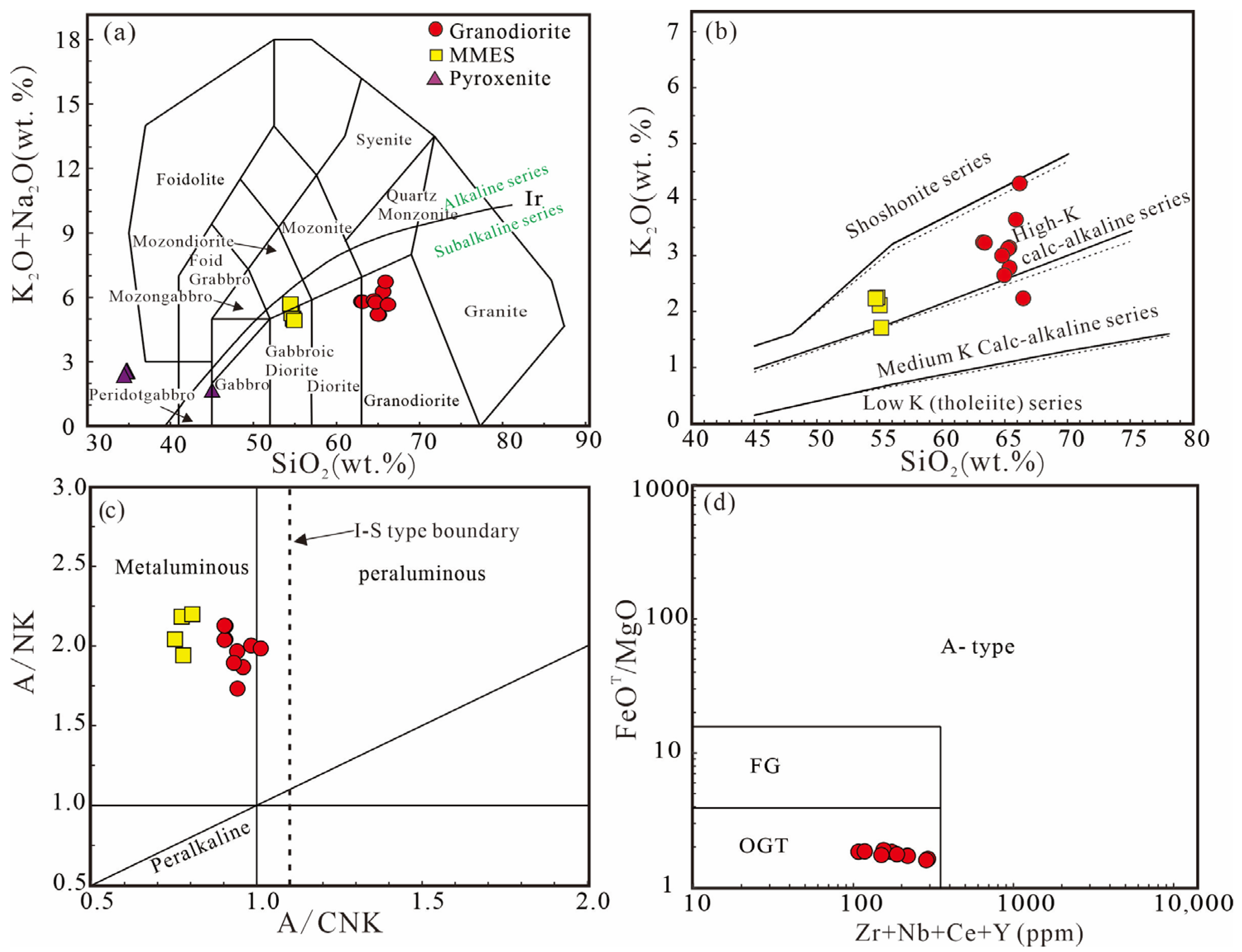
5.2.2. Sr–Nd Isotopic Compositions
5.2.3. Lu-Hf Isotopes
5.2.4. Mineral Chemistry
6. Discussion
6.1. Petrogenesis of the Early Cretaceous Granodiorite
6.2. Petrogenesis of the Early Cretaceous MMES
6.3. Petrogenesis of the Early Cretaceous Pyroxenite
6.4. Geodynamic Tectonic Implications
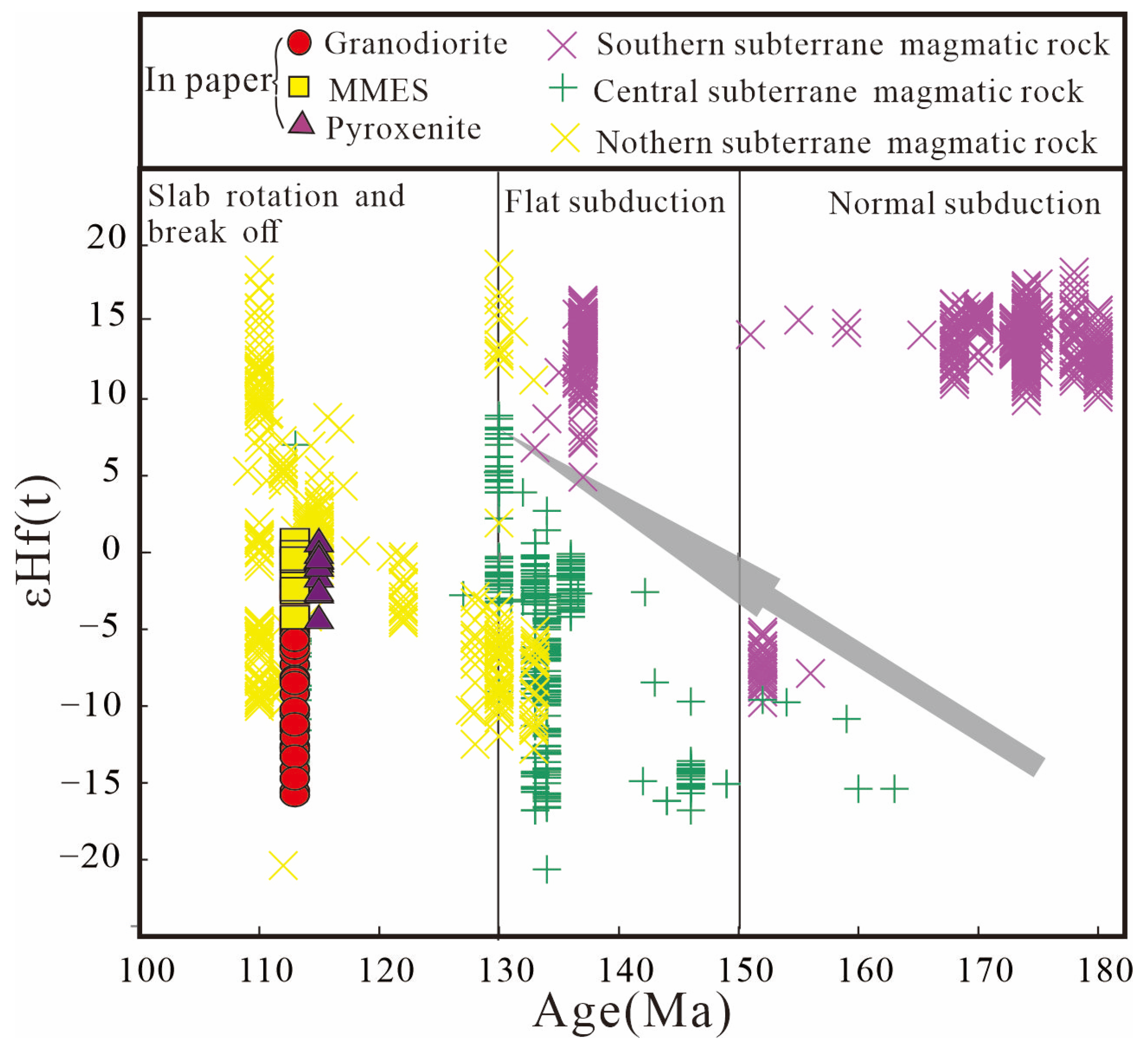
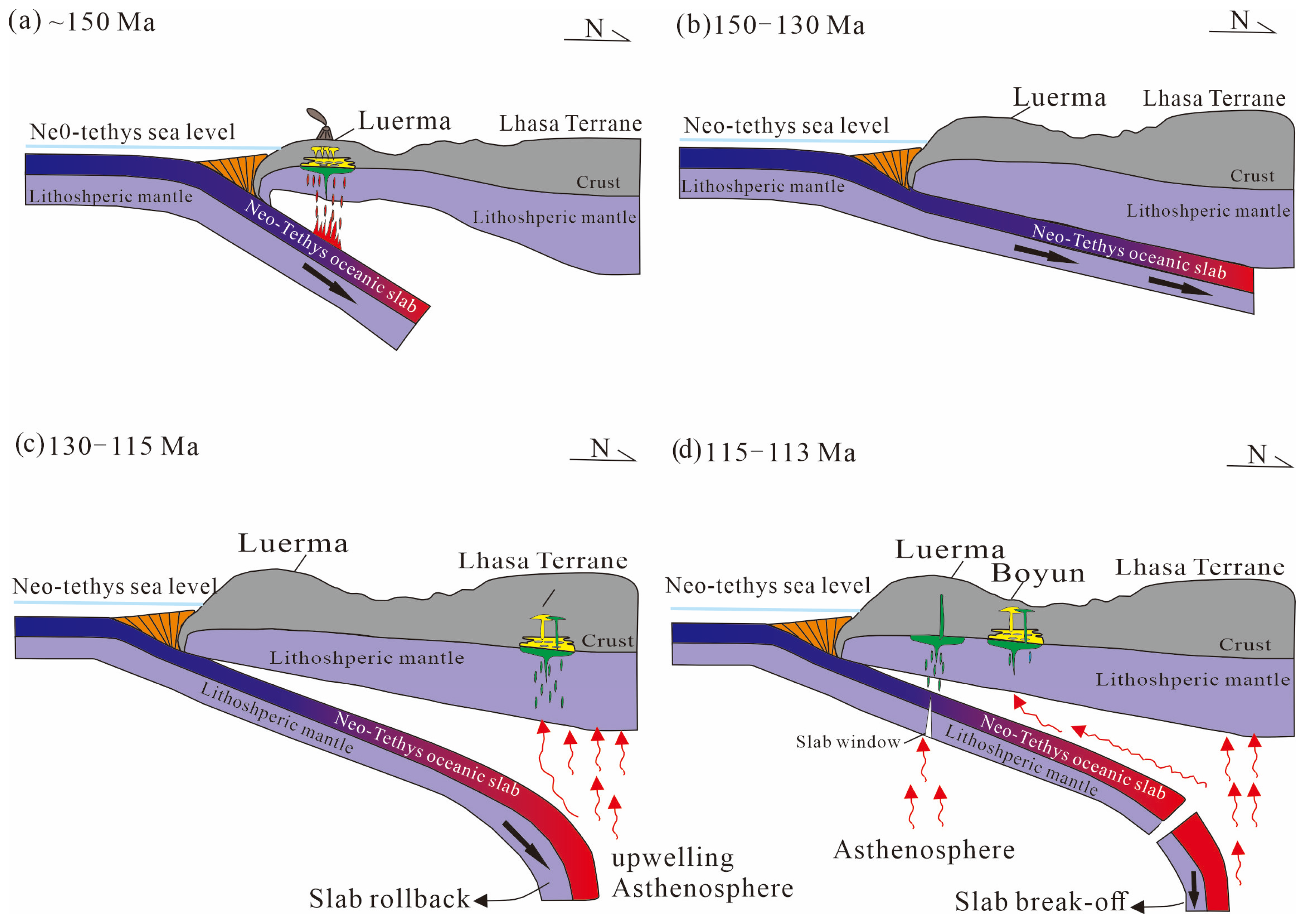
7. Conclusions
Author Contributions
Funding
Data Availability Statement
Acknowledgments
Conflicts of Interest
References
- Chang, C.F.; Chen, N.; Coward, M.; Deng, W.M.; Dewey, J.F.; Gansser, A.; Harris, N.B.W.; Jin, C.W.; Kidd, W.S.F.; Leeder, M.R.; et al. Preliminary conclusions of the Royal Society and Academia.Sinica 1985 geotraverse of Tibet. Nature 1986, 323, 501–507. [Google Scholar] [CrossRef]
- Yin, A.; Harrison, T.M. Geologic evolution of the Himalayan-Tibetan orogeny. Annu. Rev. Earth Planet. Sci. 2000, 28, 211–280. [Google Scholar] [CrossRef]
- Wang, X.H.; Lang, X.H.; Tang, J.X.; Deng, Y.L.; Cui, Z.W. Early-Middle Jurassic (182~170 Ma) Ruocuo adakitic porphyries, southern margin of the Lhasa Terrane, Tibet: Implications for geodynamic setting and porphyry Cu–Au mineralization. J. Asian Earth Sci. 2019, 173, 336–351. [Google Scholar] [CrossRef]
- Mo, X.X.; Dong, G.C.; Zhao, Z.D.; Guo, T.Y.; Wang, L.L.; Chen, T. Timing of magma mixing in the Gangdese magmatic belt during the India-Asia collision: Zircon SHRIMP U-Pb dating. Acta Geol. Sin. 2005, 79, 66–76. [Google Scholar] [CrossRef]
- Zhang, H.; Ji, W.Q.; Zhang, S.H.; Wang, J.G.; Wu, F.Y. Zircon U-Pb age and Hf isotope of intrusive rocks from the Yawa area in the west part of southern Lhasa Terrane, Tibet. Acta Petrol. Sin. 2019, 35, 423–438. [Google Scholar] [CrossRef]
- Zhu, D.C.; Wang, Q.; Zhao, Z.D.; Sun, L.C.; Cawood, P.A.; Niu, Y.L.; Liu, S.A.; Wu, F.Y.; Mo, X.X. Magmatic record of India-Asia collision. Sci. Rep. 2015, 5, 14289. [Google Scholar] [CrossRef]
- Zhu, D.C.; Zhao, Z.D.; Pan, G.T.; Lee, H.Y.; Kang, Z.Q.; Liao, Z.L.; Wang, L.Q.; Li, G.M.; Dong, G.C.; Liu, B. Early cretaceous subduction-related adakite-like rocks of the Gangdese Belt, southern Tibet: Products of slab melting and subsequent melt–peridotite interaction? J. Asian Earth Sci. 2009, 34, 298–309. [Google Scholar] [CrossRef]
- Wang, C.; Ding, L.; Liu, Z.C.; Zhang, L.Y.; Yue, Y.H. Early Cretaceous bimodal volcanic rocks in the southern Lhasa Terrane, south Tibet: Age, petrogenesis and tectonic implications. Lithos 2017, 268–271, 260–273. [Google Scholar] [CrossRef]
- Wang, L.; Zeng, L.S.; Gao, L.E.; Chen, Z.Y. Early Cretaceous high Mg# and high Sr/Y clinopyroxene-bearing diorite in the southeast Gangdese batholith, Southern Tibet. Acta Petrol. Sin. 2013, 29, 1977–1994. [Google Scholar]
- Wu, F.Y.; Ji, W.Q.; Liu, C.Z.; Sun, L.C. Detrital zircon U–Pb and Hf isotopic data from the Xigaze fore-arc basin: Constraints on Transhimalayan magmatic evolution in southern Tibet. Chem. Geol. 2010, 271, 13–25. [Google Scholar] [CrossRef]
- Niu, Y.L. Subduction initiation, Trench retreat and global tectonic consequence: The origin of back arc basins in the western Pacific and effect on China geology since the Mesozoic. In Plate Tectonics. Geological Events and Resources: New Advances in Geological Sciences; Beijing Science Press: Beijing, China, 2013; pp. 1–25. [Google Scholar]
- Pan, G.T.; Mo, X.X.; Hou, Z.Q.; Zhu, D.C.; Wang, L.Q.; Li, G.M.; Zhao, Z.D.; Geng, Q.R.; Liao, Z.L. Spatial temporal framework of the Gangdese orogenic Belt and its evolution. Acta Petrol. Sin. 2006, 22, 521–533. [Google Scholar]
- Zhu, D.C.; Pan, G.T.; Mo, X.X.; Wang, L.Q.; Liao, Z.L.; Zhao, Z.D.; Dong, G.C.; Zhou, C.Y. Late Jurassic-Early Cretaceous geodynamic setting in middle-northern Gangdese: New insight from volcanic rocks. Acta Petrol. Sin. 2006, 22, 534–546. [Google Scholar] [CrossRef]
- Zhu, D.C.; Mo, X.X.; Niu, Y.L.; Zhao, Z.D.; Wang, L.Q.; Liu, Y.S.; Wu, F.Y. Geochemical investigation of Early Cretaceous igneous rocks along and east-west traverse Throughout the central Lhasa Tibet. Chem. Geol. 2009, 268, 298–312. [Google Scholar] [CrossRef]
- Zhu, D.C.; Li, S.M.; Peter, A.; Cawood, P.A.; Wang, Q.; Zhao, Z.D.; Liu, S.A.; Wang, L.Q. Assembly of the Lhasa and Qiangtang Terranes in central Tibet by divergent double subduction. Lithos 2016, 245, 7–17. [Google Scholar] [CrossRef]
- Liu, Y.S.; Gao, S.; Hu, Z.C.; Zong, K.Q.; Wang, D.B. Continental and oceanic crust recycling-induced melt-peridotite interactions in the Trans-North China Orogen: U-Pb dating, Hf isotopes and trace elements in zircons from mantle xenoliths. J. Petrol. 2010, 1, 537–571. [Google Scholar] [CrossRef]
- Liu, Y.S.; Hu, Z.C.; Zong, K.Q.; Gao, C.G.; Gao, S.; Xu, J.; Chen, H.H. Reappraisement and Refinement of Zircon U-Pb Isotope and Trace Element Analyses by LA-ICP-MS. Chin. Sci. Bull. 2010, 55, 1535–1546. [Google Scholar] [CrossRef]
- Li, X.H.; Liu, D.Y.; Sun, M.; Li, W.X.; Lang, X.R.; Liu, Y. Precise Sm-Nd and U-Pb siotopic dating of the super-giant Shizhuyuan polymetallic deposit and its host granite, southeast China. Geol. Mag. 2004, 141, 225–231. [Google Scholar] [CrossRef]
- Hoskin, P.W.O.; Schaltegger, U. The composition of zircon and igneous and metamorphic petrogenesis. Rev. Mineral. Geochem. 2003, 53, 27–62. [Google Scholar] [CrossRef]
- Wilson, M. Igneous Petrogenesis: A Global Tectonic Approach; Unwin Hyman: London, UK, 1989. [Google Scholar]
- Irvine, T.N.; Baragar, W.R.A. A guide to the chemical classification of the common volcanic rocks. Can. J. Earth Sci. 1971, 8, 52–548. [Google Scholar] [CrossRef]
- Rollison, H.R. Using Geochemical Data: Evaluation, Presentation, Interpretation; Longman Group UK Ltd.: London, UK, 1993. [Google Scholar]
- Maniar, P.D.; Piccoli, P.M. Tectonic discrimination of granitoids. Geol. Soc. Am. Bull. 1989, 101, 635–643. [Google Scholar] [CrossRef]
- Whalen, J.B.; Currie, K.L.; Chappell, B.W. A type granites: Geochemical characteristics, discrimination and petrogenesis. Contrib. Mineral. Petrol. 1987, 95, 407–419. [Google Scholar] [CrossRef]
- Zhang, Y.L.; Xu, Y.G. Pyroxenites: High-Pressure Segregates or Recycled Oceanic Crust? Geol. J. China Univ. 2012, 18, 74–87. [Google Scholar] [CrossRef]
- Sun, S.S.; McDonough, W.F. Magmatism in Ocean Basins. In Chemical and Isotopic Systematics of Oceanic Basalts: Implications for Mantle Composition and Processes; Sanders, A.D., Norry, M.J., Eds.; Geological Society London Special Publications: Bath, UK, 1989; Volume 42, pp. 313–345. [Google Scholar]
- Zeng, Y.C.; Xu, J.F.; Ducea, M.N.; Chen, J.L.; Huang, F.; Zhang, L. Initial rifting of the Lhasa Terrane from Gondwana: Insights from the Permian (~262 Ma) amphibole-rich lithospheric mantle-derived Yawa basanitic intrusions in southern Tibet. J. Geophys. Res. Solid Earth 2019, 124, 2564–2581. [Google Scholar] [CrossRef]
- Hou, Z.Q.; Yang, Z.M.; Lu, Y.J.; Kemp, A.; Zheng, Y.C.; Li, Q.Y.; Tang, J.X.; Yang, Z.S.; Duan, L.F. A Genetic Linkage between Subduction- and Collision-Related Por-phyry Cu Deposits in Continental Collision Zones. Geology 2015, 43, 247–250. [Google Scholar] [CrossRef]
- Morimoto, N. Nomenclature of pyroxenes. Mineral. Petrol. 1988, 9, 55–76. [Google Scholar] [CrossRef]
- Wu, C.L.; Yang, J.S.; Xu, Z.Q. Mineral Chemistry of Pyroxenite Xenoliths from Hoh Xil and Their Geological Significance. Sci. China (Ser. D) 2001, 31, 109–116. [Google Scholar]
- Xiao, X. Geochronology, geochemistry and evolution of the lithospheric mantle peridotites and pyroxenites in two typical regions of China. China Univ. Geosci. 2023, 4, 59. [Google Scholar] [CrossRef]
- Chappell, B.W.; White, A.J.R. Two contrasting granite types. Pacif. Geol. 1974, 8, 173–174. [Google Scholar]
- Loiselle, M.C.; Wones, D.R. Characteristics and origin of anor-ogenic granites. Geol. Soc. Am. Abst. Prog. 1979, 11, 468. [Google Scholar]
- Pitcher, W.S. The Nature and Origin of Granite; Blackie Academic and Professional: London, UK, 1997; p. 194. [Google Scholar]
- Pichavant, M.; Montel, J.M.; Richard, L.R. Apatite solubility in peraluminous liquids: Experimental data and an extension of the Harrison-Watson model. Geochim. Cosmochim. Acta 1992, 56, 3855–3861. [Google Scholar] [CrossRef]
- Johannes, W.; Holtz, F. Petrogenesis and Experimental Petrology of Granitic Rocks; Springer: Berlin/Heidelberg, Germany, 1996. [Google Scholar]
- Jiang, Y.H.; Jiang, S.Y.; Ling, H.F.; Dai, B.Z. Low-degree melting of a metasomatized lithospheric mantle for the origin of Cenozoic Yulong monzogranite-porphyry, east Tibet: Geochemical and Sr-Nd-Pb-Hf isotopic constraints. Earth Planet. Sci. Lett. 2006, 241, 617–633. [Google Scholar] [CrossRef]
- Zhang, L.L.; Zhu, D.C.; Zhao, Z.D.; Liao, Z.L.; Wang, L.Q.; Mo, X.X. Early Cretaceous granitoids in Xainza, Tibet: Evidence of slab break-off. Acta Petrol. Sin. 2011, 27, 1938–1948. [Google Scholar]
- Zhang, X.Q.; Zhu, D.C.; Zhao, Z.D.; Sui, Q.L.; Wang, Q.; Yuan, S.H.; Hu, Z.C.; Mo, X.X. Geochemistry, zircon U-Pb geochronology and in-situ Hf isotope of the Maiga batholith in Coqen, Tibet: Constraints on the petrogenesis of the Early Cretaceous granitoids in the central Lhasa Terrane. Acta Petrol. Sin. 2012, 28, 1615–1634. [Google Scholar]
- Yan, J.J.; Zhao, Z.D.; Liu, D.; Wang, Z.Z.; Tang, Y. Geochemistry and petrogenesis of the Late Jurassic Xuru Tso batholith in central Lhasa Terrane, Tibet. Acta Petrol. Sin. 2017, 33, 2437–2453. [Google Scholar]
- Zorpi, M.J.; Coulon, C.; Orsini, J.B. Hybridization between Felsic and Mafic Magmas in Calc-Alkaline Grantoids-A Case Study in Northern Sardinia, Italy. Chem. Geol. 1991, 92, 45–86. [Google Scholar] [CrossRef]
- Rudnick, R.L.; Gao, S.S. Composition of them the Continental Crust. In Check Treatise Geochemistry; Rudnick, R.L., Holland, H.D., Turekian, K.T., Eds.; Elsevier: Amsterdam, The Netherlands, 2003; Volume 3, pp. 1–64. [Google Scholar]
- Salters, V.J.M.; Stracke, A. Composition of the De-pleted Mantle. Geochem. Geophys. Geosyst. 2004, 5, 1–27. [Google Scholar] [CrossRef]
- Mo, X.X.; Dong, G.C.; Zhao, Z.D.; Zhu, D.C.; Zhou, S. Mantle input to the crust in southern Gangdese, Tibet, during the Cenozoic: Zircon Hf isotopic evidence. J. Earth Sci. 2009, 20, 241–249. [Google Scholar] [CrossRef]
- White, W.M.; Patchett, P.J. Hf-Nd-Sr istopes and incompatible element abundances in island arcs: Implications for magma origins and crust-mantle evolution. Earth Planet. Sci. 1984, 67, 167–185. [Google Scholar] [CrossRef]
- Holden, P.; Halliday, A.N.; Stephens, W.E. Neodymium and strontium isotope content of microdiorite enclaves points to mantle input to granitoids production. Nature 1987, 330, 53–56. [Google Scholar] [CrossRef]
- Chappell, B.W.; White, A.R.J. Restite enclaves and the restite model. In Enclaves and Granite Petrology; Didier, J., Barbarin, B., Eds.; Elsevier: Amsterdam, The Netherlands, 1991; pp. 375–381. [Google Scholar]
- Bonin, B. Do coeval mafic and felsic magma in post-collisional to within-plate regimes necessarily imply two contrasting mantle and crustal, Source. A review. Lithos 2004, 17, 1–24. [Google Scholar] [CrossRef]
- Yang, J.H.; Wu, F.Y.; Wilde, S.A.; Chu, M.F. Tracing magma mixing in granite geneisis: In situ U-Pb dating and Hf –isotope and analysis of zircons. Contrib. Mineral. Petrol. 2006, 153, 177–190. [Google Scholar] [CrossRef]
- Guan, Q.; Zhu, D.C.; Zhao, Z.D.; Dong, G.C.; Zhang, L.L.; Li, X.W.; Liu, M.; Mo, X.X.; Liu, Y.S.; Yuan, H.L. Crustal thickening prior to 38Ma in southern Tibet: Evidence from lower crust-derived adakitic magmatism in the Gangdese Batholith. Gondwana Res. Int. Geosci. J. 2012, 21, 88–99. [Google Scholar] [CrossRef]
- Kong, H.L.; Liu, Y.G.; Zhang, J.W.; Lin, J.Q.; Jia, Q.Z.; Li, J.C.; Gao, Y.J. Petrogenesis and tectonic implications of the quartz diorites and mafic microgranular enclaves in the Asiha gold ore deposit in the East Kunlun orogenic belt: Evidence from zircon U–Pb dating, geochemistry, and Sr-Nd-Hf isotopes. Geol. J. 2022, 57, 1759–1782. [Google Scholar] [CrossRef]
- Wu, F.Y.; Jahn, B.M.; Wilde, S.A.; Lo, C.H.; Yui, T.F.; Lin, Q.; Ge, W.C.; Sun, D.Y. Highly Frac-tionated I-Type Granites in NE China (I): Geochronology and Petrogenesis. Lithos 2003, 66, 241–273. [Google Scholar] [CrossRef]
- Hofmann, A.W.; Jochum, K.P.; Seufert, M.; White, W.M. Nb and Pb in oceanic basalts new constraints on mantle evolution. Earth Planet. Sci. Lett. 1986, 79, 33–45. [Google Scholar] [CrossRef]
- Leslie, R.A.J.; Danyushevsky, L.V.; Crawford, A.J.; Verbeeten, A.C. Primitive shoshonites from Fiji: Geochemistry and source components. Geochem. Geophys. Geosyst. 2009, 10, 131–147. [Google Scholar] [CrossRef]
- Bizimis, M.; Sen, G.; Salters, J.M.; Keshav, S. Hf-Nd-Sr istope systematics of garnet pyroxenites from Salt Lake Crater, Oahu Hawaii: Evidence for a depleted component in Hawaiian vocanism. Geochim. Cosmochim. Acta 2005, 69, 2629–2646. [Google Scholar] [CrossRef]
- Bodinier, J.L.; Godard, M. Orogenic, ophiolitic and abssal peridotites. In The Mantle and Core: Treatise on Geochemistry; Elsevier: Amsterdam, The Netherlands, 2003; Volume 2, pp. 103–170. [Google Scholar]
- Gysi, A.P.; Jagoutz, O.; Schmidt, M.W.; Targuisti, K. Petrogenesis of Pyroxenites and Melt Infiltrations in the Ultramafic Complex of Beni Bousera, Northern Morocco. J. Petrol. 2011, 52, 1679–1735. [Google Scholar] [CrossRef]
- Harlow, G.E. K in clinopyroxene at high pressure and temperature: An experimental study. Am. Mineral. 1997, 82, 259–269. [Google Scholar] [CrossRef]
- Tsuruta, K.; Takhaashi, E. Melting study of an alkali basalt JBI Up to 12.5GPa: Behavior of Potassiumin the deep mantle. Phys. Earth Planet. Inter. 1998, 107, 119–130. [Google Scholar] [CrossRef]
- Wang, W.Y.; Tkahashi, E. Subsolidus and melting experiments of a K-rich basaltic composition to 27GPa: ImPliCation for the behavior of Potassiumin the mantle. Am. Mineral. 1999, 84, 357–361. [Google Scholar] [CrossRef]
- Condamine, P.; Médard, E.; Devidal, J.L. Experimental melting of phlogopite-peridotite in the garnet stability field. Contrib. Mineral. Petrol. 2016, 171, 95. [Google Scholar] [CrossRef]
- Bowman, E.E.; Ducea, M.N. Pyroxenite melting at subduction zones. Geology 2023, 51, 383–386. [Google Scholar] [CrossRef]
- Pearce, J.A.; Kempton, P.D.; Nowell, G.M.; Noble, S.R. Hf-Nd element and isotope perspective on the nature and provenance of mantle and subduction components in Western Pacific arc-basin systems. J. Petrol. 1999, 40, 1579–1611. [Google Scholar] [CrossRef]
- Zhu, D.C.; Zhao, Z.D.; Niu, Y.L.; Dilek, Y.; Mo, X.X. Lhasa Terrane in southern Tibet came from Australia. Geology 2011, 39, 727–730. [Google Scholar] [CrossRef]
- Chu, M.F.; Chung, S.L.; Song, B.; Liu, D.Y.; O’Reilly, S.Y.; Pearson, N.J.; Ji, J.Q.; Wen, D.J. Zircon U-Pb and Hf isotope constraints on the Mesozoic tectonics and crustal evolution of Southern Tibet. Geology 2006, 34, 745–748. [Google Scholar] [CrossRef]
- Kapp, P.; DeCelles, P.G.; Gehrels, G.E.; Heizler, M.; Ding, L. Geological records of the Lhasa–Qiangtang and Indo-Asian collisionsin the Nima area of central Tibet. Geol. Soc. Am. Bull. 2007, 119, 917–933. [Google Scholar] [CrossRef]
- Leier, A.L.; Kapp, P.; Decelles, P.G.; Gehrels, G.E. Lower Cretaceous strata in the Lhasa Terrane, Tibet, with implications for understanding the eraly tectonic history of the Tibetan plateau. J. Sediment. Res. 2007, 77, 809–825. [Google Scholar] [CrossRef]
- Ji, W.Q.; Wu, F.Y.; Chung, S.L.; Li, J.X.; Liu, C.Z. Zircon U-Pb geochronology and Hf isotopic constraints on petrogenesis of the Gangdese batholith, southern Tibet. Chem. Geol. 2009, 262, 229–245. [Google Scholar] [CrossRef]
- Zheng, H.; Huang, Q.T.; Cai, Z.R.; Zhang, K.J.; Liu, H.C.; Cheng, C.; Lu, L.J.; Yang, P.; Yu, S.R. Early Cretaceous arc granitoids from the central Lhasa subTerrane: Production of the northward subduction of Yarlung Zangbo Neo-Tethyan Ocean? Geol. J. 2020, 6, 4001–4013. [Google Scholar] [CrossRef]
- Wang, Y.L.; Zhang, C.J.; Xiu, S.Z. Th/Hf-Ta/Hf Identification of Tectonic Setting of Basalts. Acta Petrol. Sin. 2001, 17, 413–421. [Google Scholar]
- Pearce, J.A.; Harris, N.B.; Tindle, A.G. Trace element discrimination diagrams for the tectonic interpretation of granitic rocks. J. Petrol. 1984, 25, 956–983. [Google Scholar] [CrossRef]
- Kapp, P.; Murphy, M.A.; Yin, A.; Harrison, T.M.; Ding, L.; Guo, J.H. Mesozoic and Cenozoic tectonic evolution of the Shiquanhe area of western Tibet. Tectonics 2003, 22, 1029. [Google Scholar] [CrossRef]
- Kapp, P.; Murphy, M.A.; Yin, A.; Ding, L. Cretaceous-Tertiary shortening, basin development, and volcanism in central Tibet. Geol. Soc. Am. Bull. 2005, 117, 865–878. [Google Scholar] [CrossRef]
- He, J. Magmatic Activity in the Zhongba Area of the Western Segment of the Yarlung Zangbo Suture Zone and Its Tectonic Significance; China University of Geosciences: Beijing, China, 2015. [Google Scholar]
- Zhang, C.; Liu, C.Z.; Xu, Y.; Ji, W.B.; Wang, J.M.; Wu, F.Y.; Liu, T.; Zhang, Z.Y.; Zhang, W.Q. Subduction re-initiation at dying ridge of Neo-Tethys: Insights from mafic and metamafic rocks in Lhaze ophiolitic mélange, Yarlung-Tsangbo Suture Zone. Earth Planet. Sci. Lett. 2019, 523, 115707. [Google Scholar] [CrossRef]
- Gerya, T.V.; Stern, R.J.; Baes, M.; Sobolev, S.V.; Whattam, S.A. Plate tectonics on the Earth triggered by plume-induced subduction initiation. Nature 2015, 527, 221–225. [Google Scholar] [CrossRef]
- Liu, Y.G.; Li, W.Y.; Jia, Q.Z.; Zhang, Z.W.; Wang, Z.A.; Zhang, Z.B.; Zhang, J.W.; Qian, B. The Dynamic Sulfide Saturation Process and a Possible Slab Break-off Model for the Giant Xiarihamu Magmatic Nickel Ore Deposit in the East Kunlun Orogenic Belt, Northern Qinghai-Tibet Plateau, China. Econ. Geol. 2018, 113, 1383–1417. [Google Scholar] [CrossRef]
- Dong, G.C.; Mo, X.X.; Zhao, Z.D.; Zhu, D.C.; Wang, L.L.; Chen, T.; Li, B. Magma mixing in middle Part of Gangdese magma belt: Evidences for granitoid complex. Acta Petrol. Sin. 2006, 22, 835–844. [Google Scholar] [CrossRef]
- Qi, N.Y.; Zhao, Z.D.; Tang, Y.; Yan, J.J.; Shi, Q.S.; Liu, D.; Zhu, D.C.; Sheikh, L. Geochronology, geochemistry and petrogenesis of the Late Jurassic-Early Cretaceous granitoids in Zuozuo, western Central Lhasa Terrane, Tibet. Acta Petrol. Sin. 2019, 35, 405–422. [Google Scholar] [CrossRef]
- Murphy, M.A.; Yin, A.; Harrison, T.M.; Durr, S.B.; Chen, Z.; Ryerson, F.J.; Kidd, W.S.F.; Wang, X.; Zhou, X. Did the Indo-Asian collision alone create the Tibetan plateau. Geology 1997, 25, 719–722. [Google Scholar] [CrossRef]
- Ding, L.; Lai, Q. New geological evidence of crustal thickening in the Gangdese block prior to the Indo-Asian collision. Chin. Sci. Bull. 2003, 48, 1604–1610. [Google Scholar] [CrossRef]
- Tang, M.; Ji, W.Q.; Chu, X.; Wu, A.B.; Chen, C. Reconstructing crustal thickness evolution from europium anomalies in detrital zircons. Geol. Soc. Am. 2020, 49, 76–80. [Google Scholar] [CrossRef]
- Ma, X.X.; Joseph, G.M.; Xu, Z.Q.; Yi, Z.Y. Late Triassic intra-oceanic arc system within Neotethys: Evidence from cumulate appinite in the Gangdese belt, southern Tibet. Lithosphere 2018, 4, 545–565. [Google Scholar] [CrossRef]
- Kang, Z.Q.; Xu, J.F.; Dong, Y.H.; Wang, B.D. Cretaceous volcanic rocks of Zenong Group in north-middle Lhasa Block: Products of southward subducting of the Slalnajap ocean? Acta Petrol. Sin. 2008, 24, 303–314. [Google Scholar]
- Jiang, X.; Zhao, Z.D.; Zhu, D.C.; Zhang, F.Q.; DONG, G.C.; Mo, X.X.; Guo, T.Y. Zircon U-Pb geochronology and Hf isotopic geochemistry of Jiangba, Bangba and Xiongba granitoids in western Gangdese, Tibet. Acta Petrol. Sin. 2010, 26, 2155–2164. [Google Scholar]
- Zhang, S.Q.; Qi, X.X.; Wei, C.; Chen, S.Y. Geochemistry, Zircon U-Pb Dating and Hf Isotope Compositions of Early Cretaceous Magmatic Rocks in Yongzhu Area, Northern Lhasa Terrane, Tibet. And its Geological Significance. Earth Sci. 2018, 43, 1085–1109. [Google Scholar] [CrossRef]
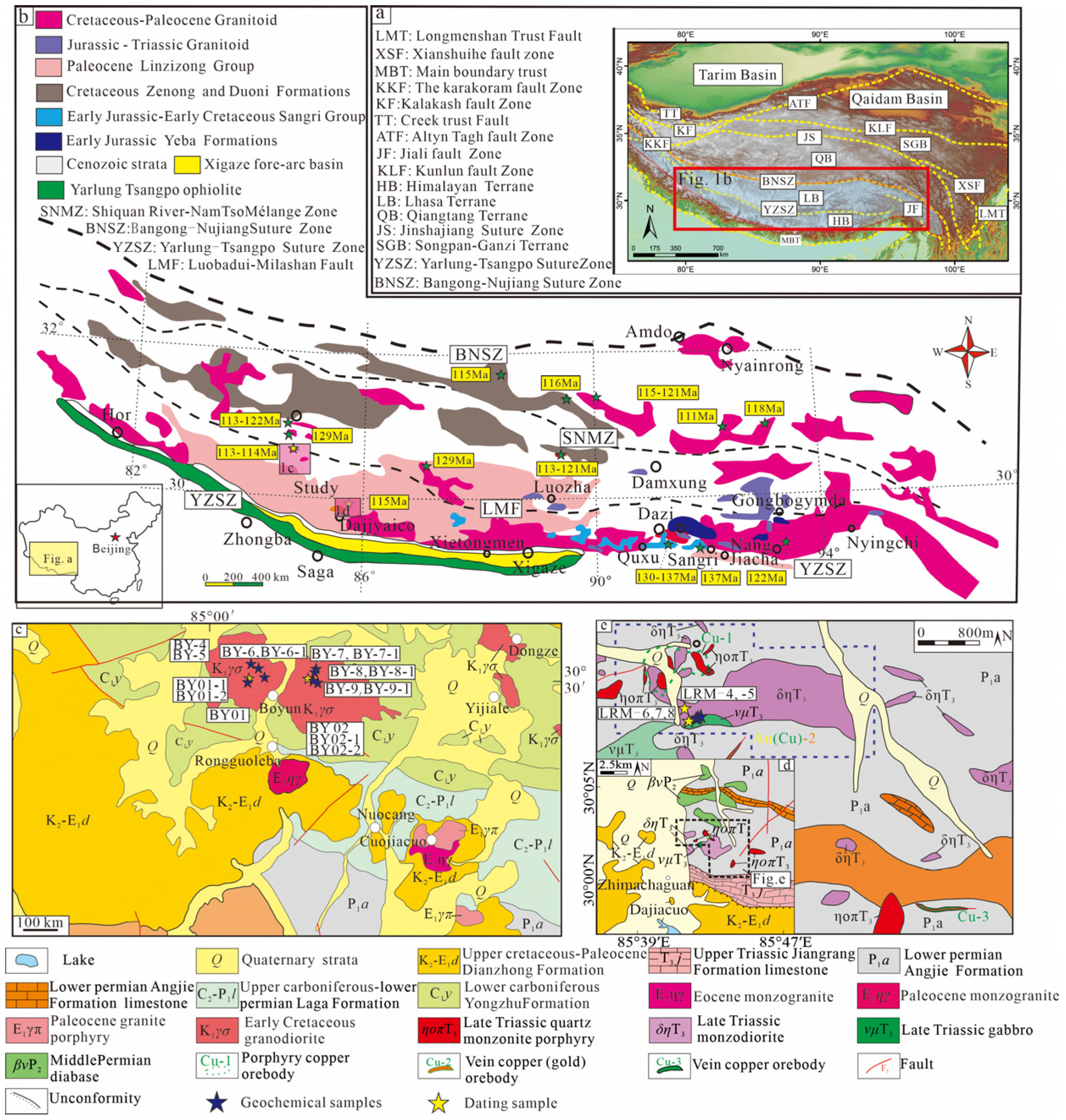
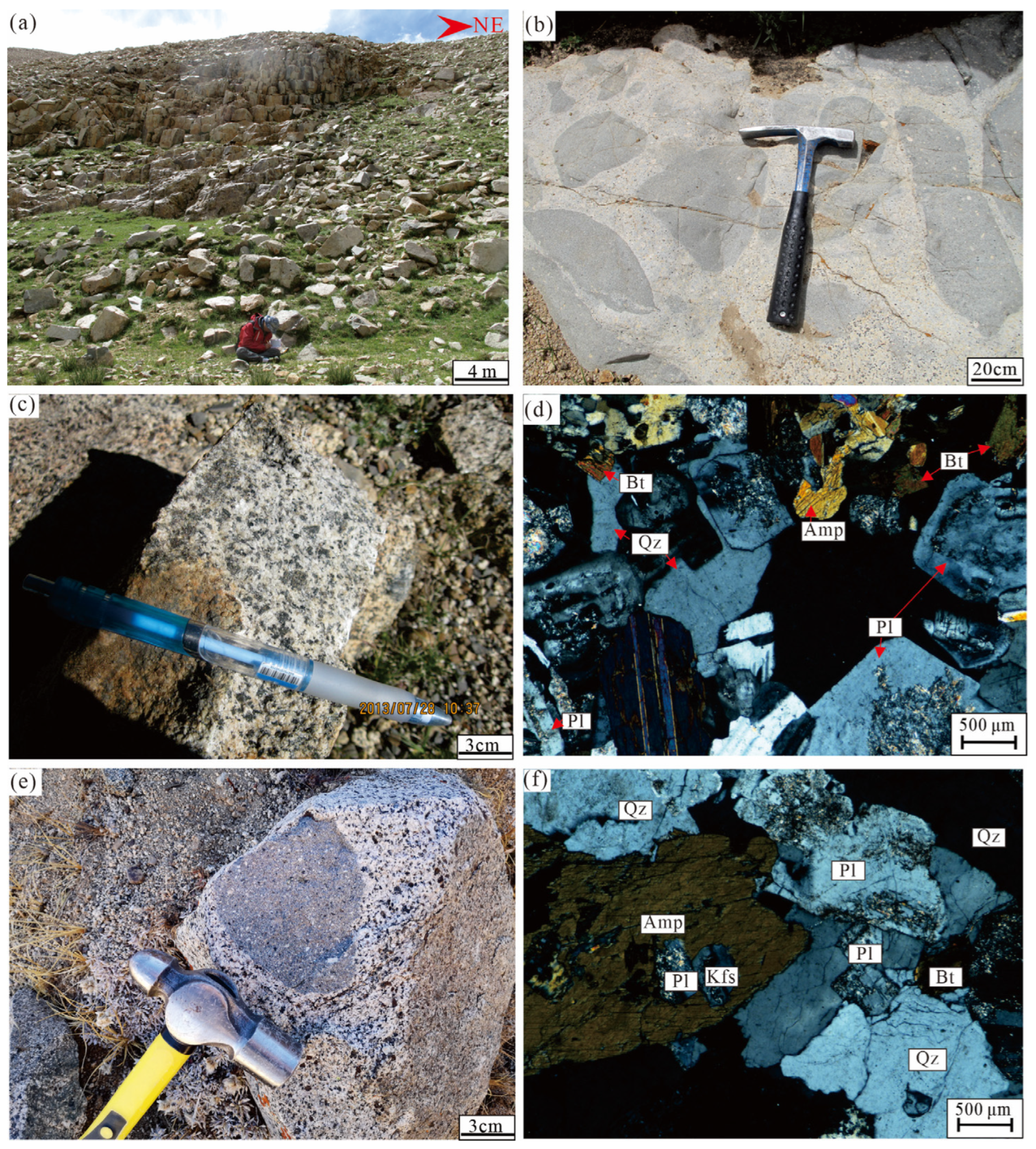
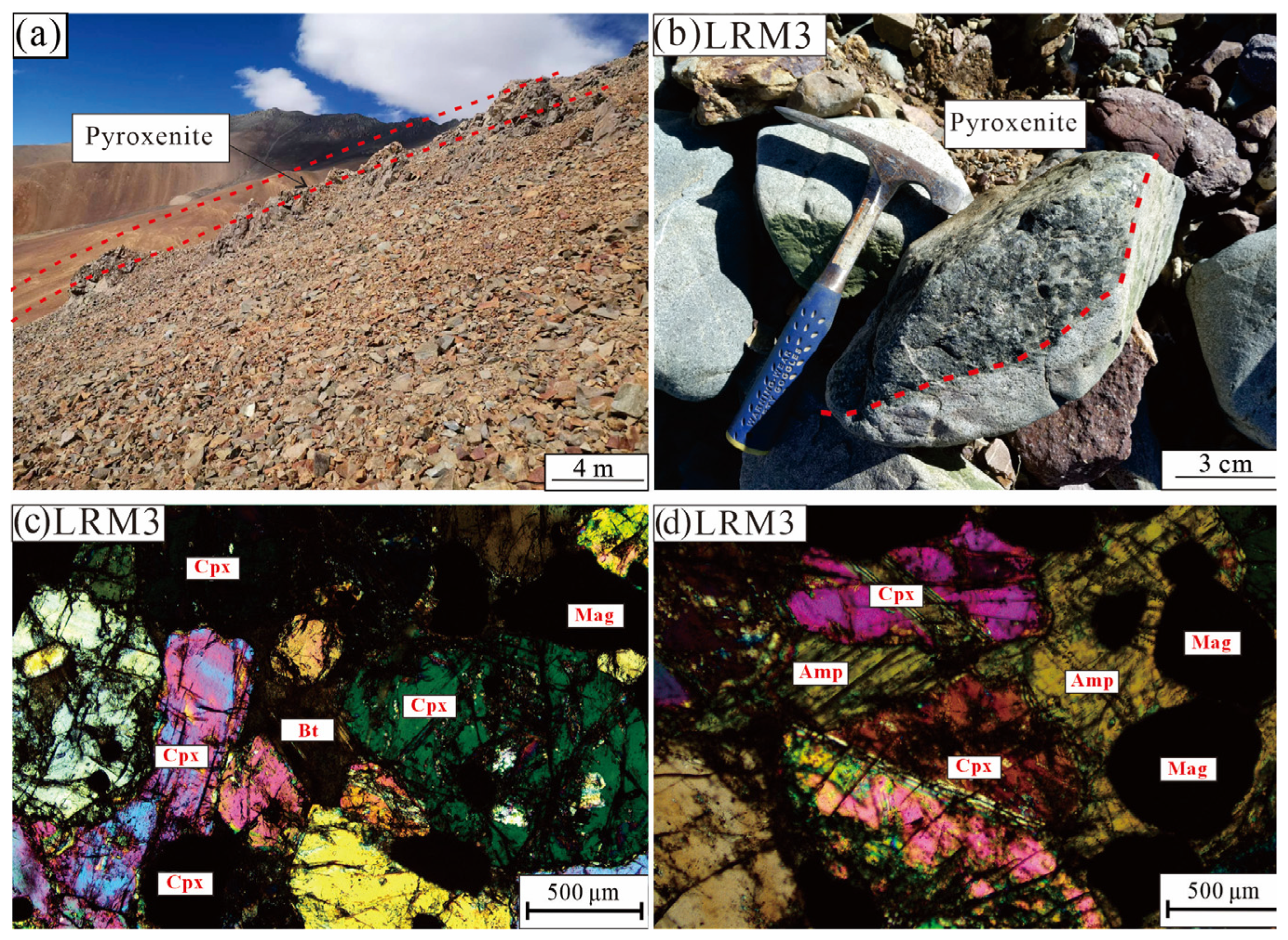
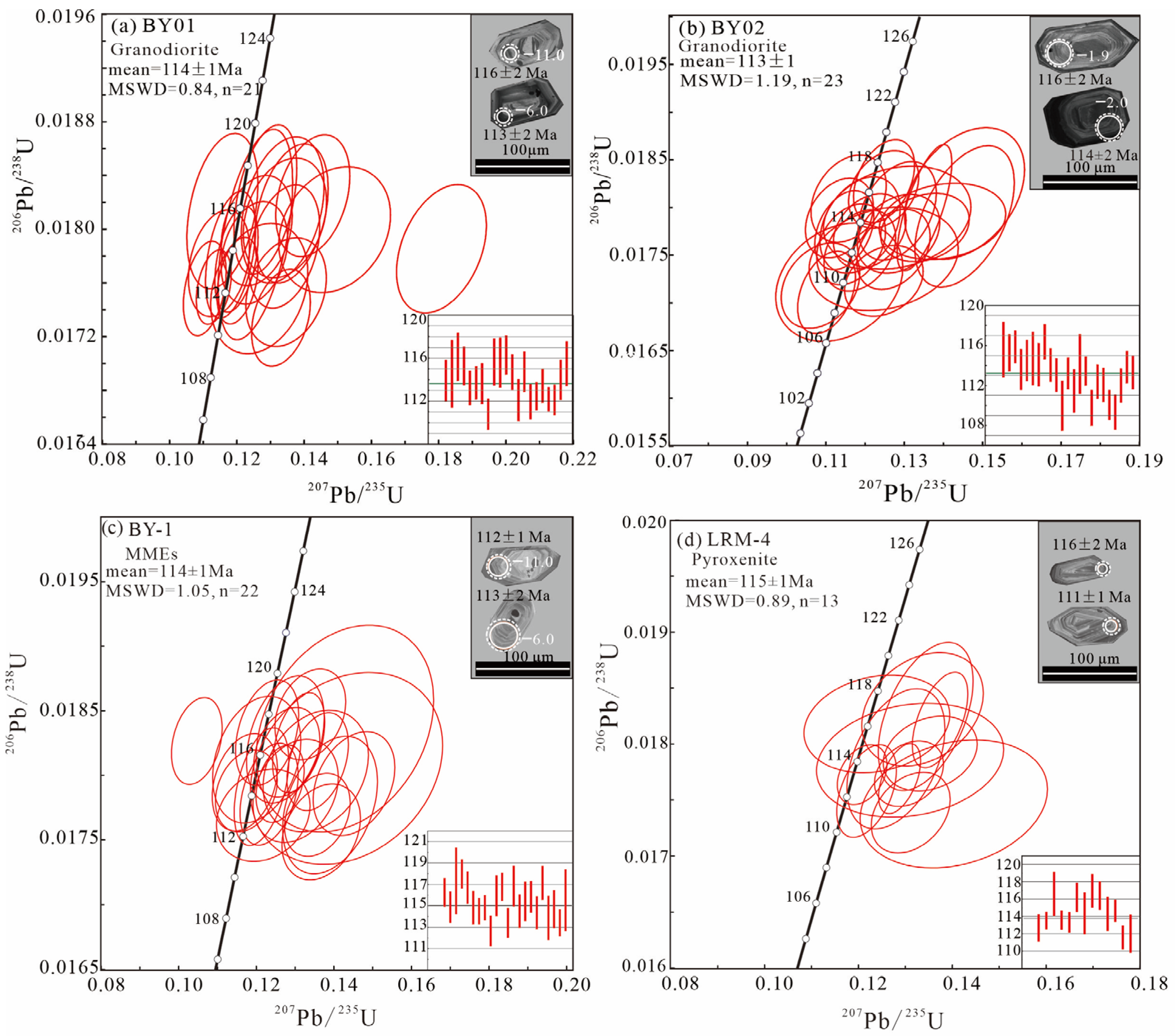


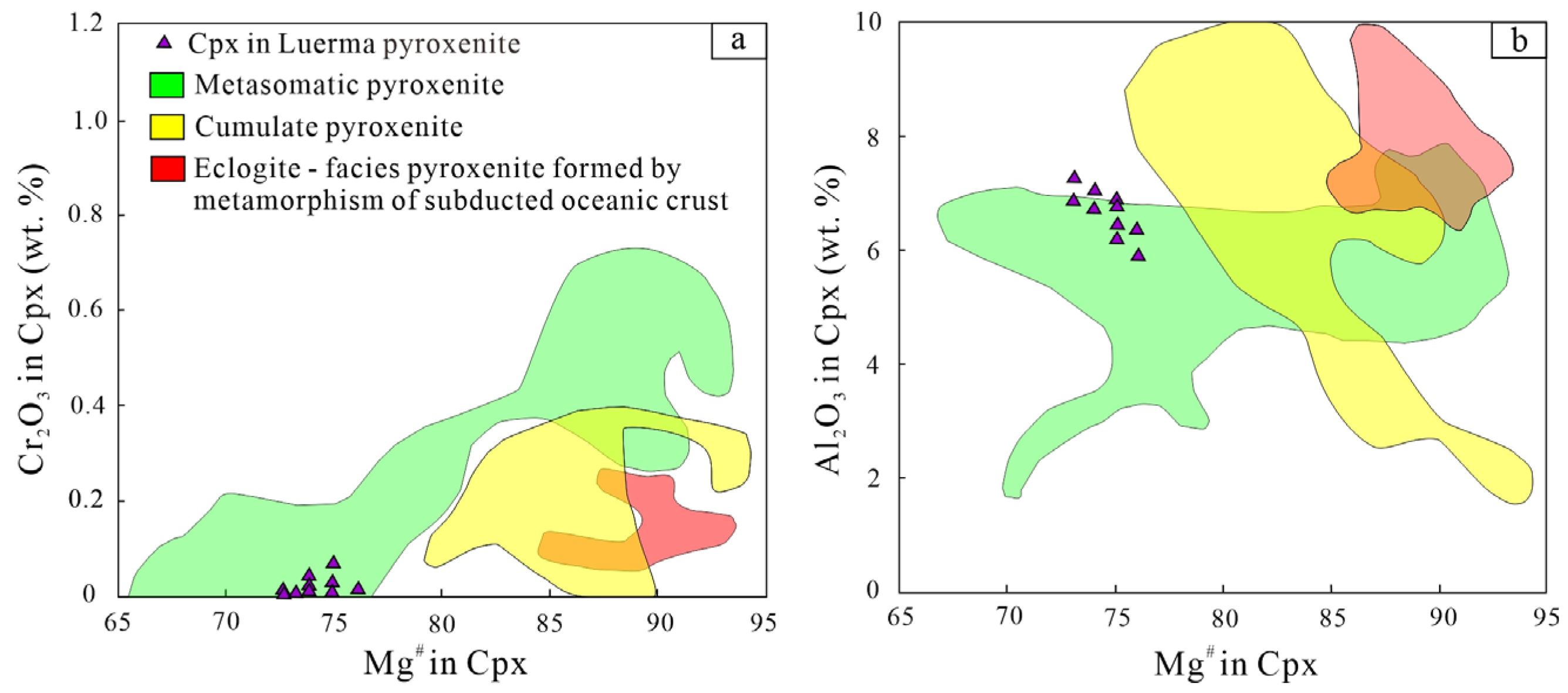
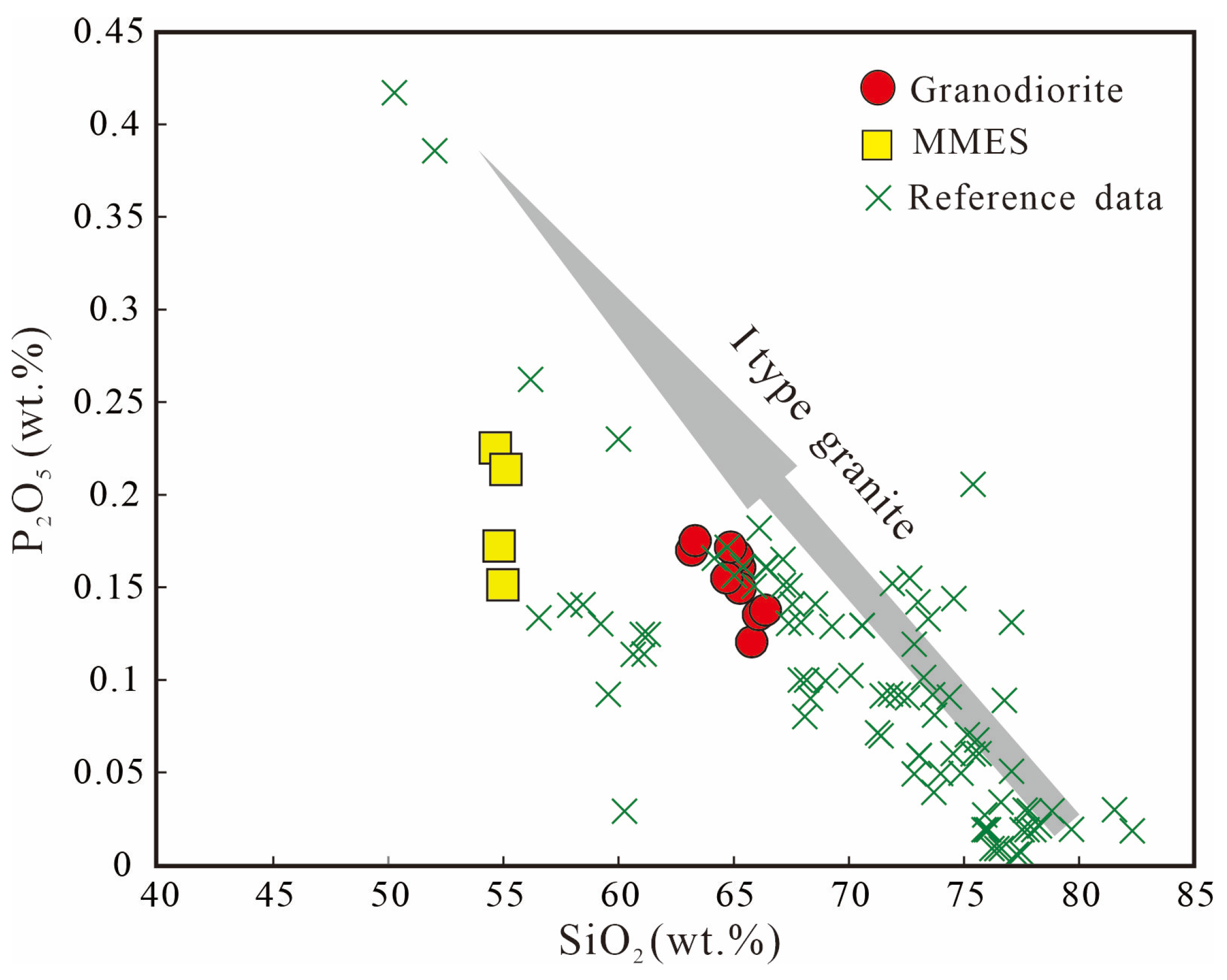
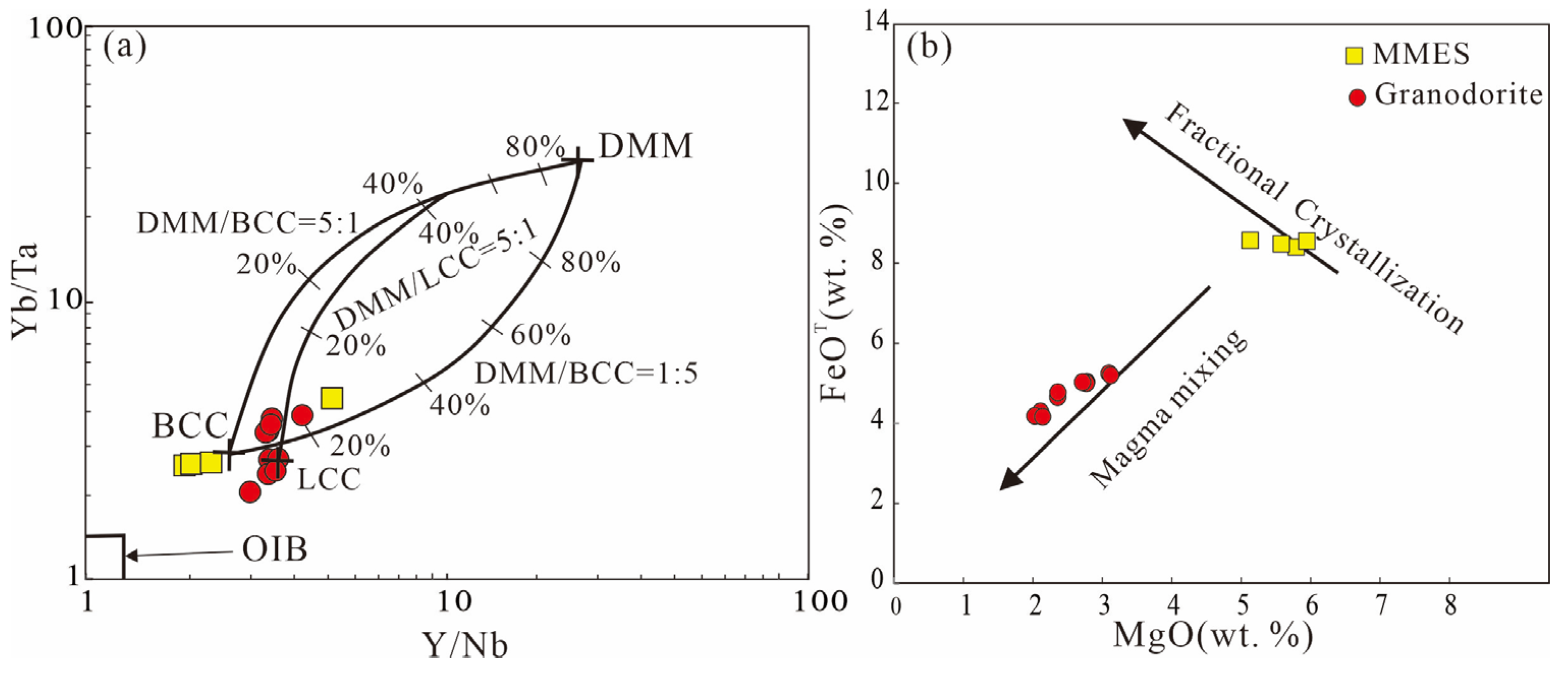
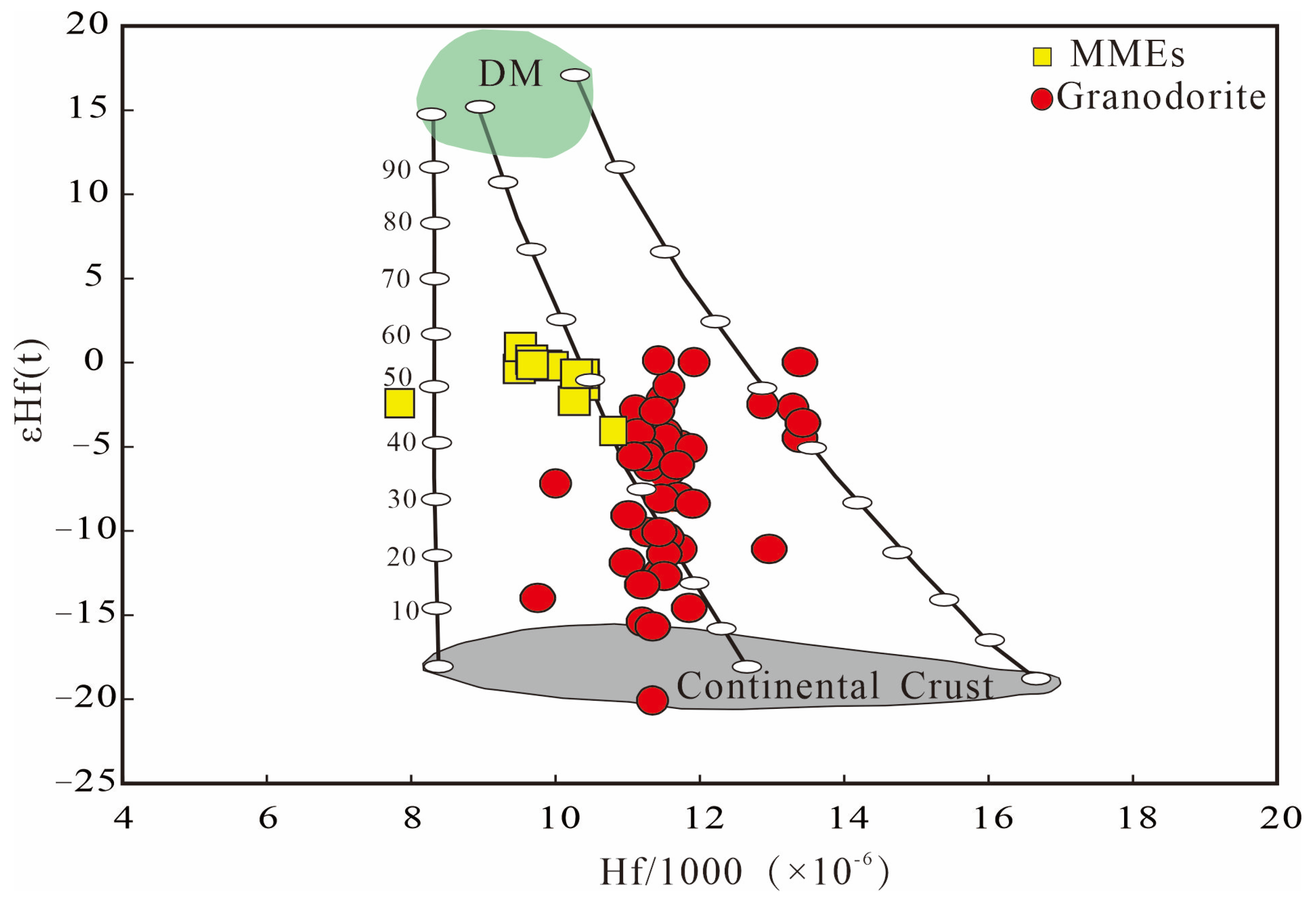
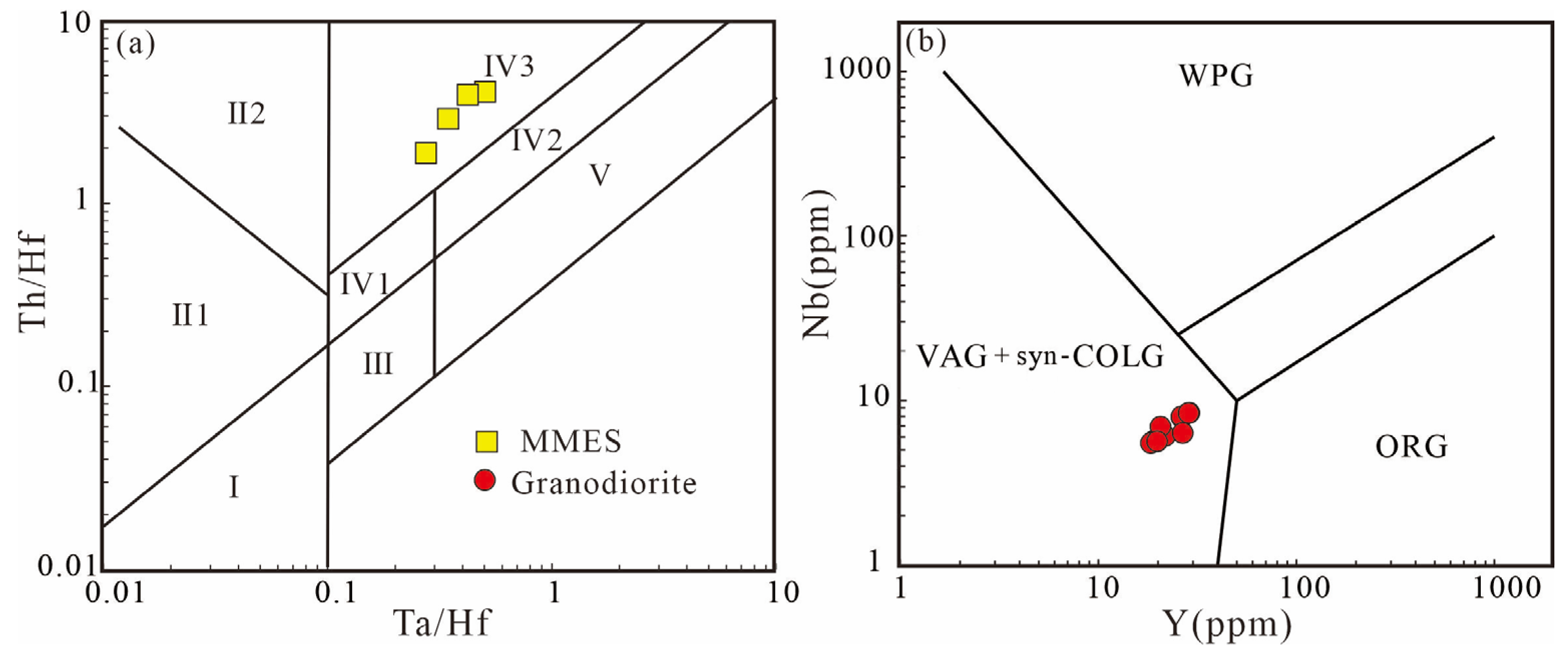
| Sample | Th | U | Th/U | 207Pb/206Pb | 1δ | 207Pb/235U | 1δ | 206Pb/238U | 1δ | 207Pb/206Pb | 1δ | 207Pb/235U | 1δ | 206Pb/238U | 1δ |
|---|---|---|---|---|---|---|---|---|---|---|---|---|---|---|---|
| LRM-4 (Proxenite) | |||||||||||||||
| LRM-4-1 | 320 | 304 | 1.05 | 0.0499 | 0.0016 | 0.1208 | 0.0042 | 0.0176 | 0.0003 | 187 | 69 | 116 | 4 | 112 | 2 |
| LRM-4-2 | 330 | 358 | 0.92 | 0.0492 | 0.0014 | 0.1198 | 0.0035 | 0.0177 | 0.0002 | 167 | 73 | 115 | 3 | 113 | 1 |
| LRM-4-5 | 563 | 446 | 1.26 | 0.0532 | 0.0026 | 0.1334 | 0.0067 | 0.0182 | 0.0004 | 345 | 105 | 127 | 6 | 117 | 3 |
| LRM-4-6 | 559 | 516 | 1.08 | 0.0532 | 0.002 | 0.1298 | 0.0048 | 0.0177 | 0.0002 | 345 | 82 | 124 | 4 | 113 | 1 |
| LRM-4-10 | 662 | 1024 | 0.65 | 0.0524 | 0.0011 | 0.1279 | 0.0029 | 0.0177 | 0.0002 | 302 | 44 | 122 | 3 | 113 | 1 |
| LRM-4-11 | 212 | 292 | 0.73 | 0.0487 | 0.0038 | 0.123 | 0.0103 | 0.0182 | 0.0003 | 200 | 106 | 118 | 9 | 116 | 2 |
| LRM-4-12 | 597 | 528 | 1.13 | 0.0516 | 0.0026 | 0.1271 | 0.0069 | 0.0179 | 0.0004 | 333 | 119 | 121 | 6 | 114 | 3 |
| LRM-4-13 | 376 | 352 | 1.07 | 0.0529 | 0.0037 | 0.1327 | 0.0086 | 0.0183 | 0.0003 | 324 | 155 | 127 | 8 | 117 | 2 |
| LRM-4-15 | 670 | 556 | 1.21 | 0.0548 | 0.0016 | 0.1365 | 0.0039 | 0.0182 | 0.0003 | 406 | 63 | 130 | 3 | 116 | 2 |
| LRM-4-19 | 235 | 247 | 0.95 | 0.0525 | 0.0052 | 0.1301 | 0.0132 | 0.0179 | 0.0003 | 309 | 228 | 124 | 12 | 114 | 2 |
| LRM-4-20 | 772 | 561 | 1.38 | 0.0546 | 0.0028 | 0.1344 | 0.0066 | 0.0179 | 0.0002 | 394 | 115 | 128 | 6 | 114 | 1 |
| LRM-4-23 | 494 | 430 | 1.15 | 0.0547 | 0.0025 | 0.1302 | 0.0056 | 0.0174 | 0.0002 | 467 | 102 | 124 | 5 | 111 | 2 |
| LRM-4-24 | 404 | 344 | 1.17 | 0.0585 | 0.0061 | 0.1394 | 0.0132 | 0.0175 | 0.0004 | 550 | 231 | 132 | 12 | 112 | 2 |
| BY01 (Granodiorite) | |||||||||||||||
| BY01-1 | 199 | 247 | 0.8 | 0.0736 | 0.0035 | 0.1808 | 0.0088 | 0.0179 | 0.0003 | 1031 | 97 | 169 | 8 | 114 | 2 |
| BY01-2 | 431 | 428 | 1.01 | 0.0683 | 0.0198 | 0.1255 | 0.0073 | 0.018 | 0.0005 | 877 | 630 | 120 | 7 | 115 | 3 |
| BY01-4 | 254 | 357 | 0.71 | 0.0512 | 0.0023 | 0.1285 | 0.0062 | 0.0182 | 0.0004 | 254 | 104 | 123 | 6 | 116 | 2 |
| BY01-6 | 397 | 422 | 0.94 | 0.0543 | 0.0035 | 0.1343 | 0.0082 | 0.0181 | 0.0003 | 389 | 146 | 128 | 7 | 116 | 2 |
| BY01-7 | 265 | 370 | 0.72 | 0.047 | 0.0025 | 0.1147 | 0.006 | 0.0177 | 0.0003 | 50 | 126 | 110 | 5 | 113 | 2 |
| BY01-8 | 275 | 329 | 0.84 | 0.0512 | 0.0027 | 0.1252 | 0.0065 | 0.0178 | 0.0003 | 250 | 122 | 120 | 6 | 114 | 2 |
| BY01-9 | 558 | 484 | 1.15 | 0.0482 | 0.002 | 0.1181 | 0.0049 | 0.0178 | 0.0003 | 109 | 101 | 113 | 4 | 114 | 2 |
| BY01-10 | 263 | 322 | 0.82 | 0.0557 | 0.0024 | 0.1331 | 0.0058 | 0.0173 | 0.0002 | 443 | 129 | 127 | 5 | 111 | 2 |
| BY01-11 | 103 | 199 | 0.52 | 0.0532 | 0.0029 | 0.1336 | 0.0081 | 0.0181 | 0.0004 | 339 | 126 | 127 | 7 | 116 | 2 |
| BY01-12 | 122 | 214 | 0.57 | 0.0465 | 0.003 | 0.1157 | 0.007 | 0.0181 | 0.0004 | 20 | 148 | 111 | 6 | 116 | 2 |
| BY01-13 | 180 | 252 | 0.71 | 0.057 | 0.003 | 0.1426 | 0.0073 | 0.0182 | 0.0003 | 494 | 117 | 135 | 6 | 117 | 2 |
| BY01-14 | 228 | 342 | 0.67 | 0.0509 | 0.003 | 0.1259 | 0.007 | 0.018 | 0.0003 | 239 | 135 | 120 | 6 | 115 | 2 |
| BY01-17 | 152 | 243 | 0.62 | 0.0526 | 0.004 | 0.1267 | 0.0095 | 0.0176 | 0.0003 | 322 | 174 | 121 | 9 | 112 | 2 |
| BY01-18 | 307 | 371 | 0.83 | 0.0585 | 0.0035 | 0.1491 | 0.011 | 0.018 | 0.0003 | 546 | 130 | 141 | 10 | 115 | 2 |
| BY01-19 | 202 | 304 | 0.66 | 0.0559 | 0.0032 | 0.1346 | 0.0079 | 0.0175 | 0.0003 | 456 | 125 | 128 | 7 | 112 | 2 |
| BY01-20 | 402 | 471 | 0.85 | 0.0494 | 0.0016 | 0.1202 | 0.004 | 0.0176 | 0.0002 | 169 | 71 | 115 | 4 | 113 | 1 |
| BY01-21 | 541 | 624 | 0.87 | 0.0489 | 0.0017 | 0.1199 | 0.0042 | 0.0178 | 0.0003 | 146 | 86 | 115 | 4 | 114 | 2 |
| BY01-22 | 370 | 862 | 0.43 | 0.0466 | 0.0013 | 0.1132 | 0.0034 | 0.0176 | 0.0002 | 28 | 67 | 109 | 3 | 112 | 1 |
| BY01-24 | 153 | 256 | 0.6 | 0.0548 | 0.0028 | 0.1341 | 0.007 | 0.0179 | 0.0003 | 467 | 117 | 128 | 6 | 114 | 2 |
| BY01-25 | 106 | 317 | 0.33 | 0.0547 | 0.0029 | 0.1362 | 0.0072 | 0.0181 | 0.0003 | 467 | 119 | 130 | 6 | 116 | 2 |
| BY02 (Granodiorite) | |||||||||||||||
| BY02-1 | 191 | 259 | 0.74 | 0.0585 | 0.0042 | 0.1454 | 0.0101 | 0.0181 | 0.0005 | 550 | 156 | 138 | 9 | 116 | 3 |
| BY02-2 | 335 | 380 | 0.88 | 0.0467 | 0.0026 | 0.1158 | 0.0063 | 0.0181 | 0.0003 | 35 | 130 | 111 | 6 | 116 | 2 |
| BY02-3 | 298 | 381 | 0.78 | 0.05 | 0.0024 | 0.1247 | 0.0059 | 0.0182 | 0.0003 | 195 | 113 | 119 | 5 | 116 | 2 |
| BY02-4 | 387 | 437 | 0.89 | 0.0486 | 0.003 | 0.1187 | 0.0068 | 0.0178 | 0.0003 | 132 | 202 | 114 | 6 | 114 | 2 |
| BY02-5 | 657 | 527 | 1.25 | 0.0518 | 0.0027 | 0.1282 | 0.0066 | 0.018 | 0.0003 | 276 | 122 | 122 | 6 | 115 | 2 |
| BY02-6 | 681 | 1148 | 0.59 | 0.0547 | 0.002 | 0.1352 | 0.0046 | 0.018 | 0.0004 | 398 | 79 | 129 | 4 | 115 | 3 |
| BY02-9 | 211 | 218 | 0.97 | 0.0516 | 0.005 | 0.1282 | 0.0124 | 0.0179 | 0.0004 | 333 | 222 | 122 | 11 | 114 | 2 |
| BY02-10 | 221 | 326 | 0.68 | 0.0498 | 0.0022 | 0.1248 | 0.0051 | 0.0183 | 0.0003 | 183 | 102 | 119 | 5 | 117 | 2 |
| BY02-11 | 303 | 381 | 0.8 | 0.0463 | 0.0024 | 0.1134 | 0.0057 | 0.0179 | 0.0003 | 9 | 122 | 109 | 5 | 114 | 2 |
| BY02-12 | 333 | 389 | 0.86 | 0.0527 | 0.0028 | 0.1285 | 0.0069 | 0.0177 | 0.0003 | 317 | 122 | 123 | 6 | 113 | 2 |
| BY02-13 | 372 | 480 | 0.78 | 0.0473 | 0.0041 | 0.1134 | 0.0107 | 0.0172 | 0.0004 | 65 | 193 | 109 | 10 | 110 | 3 |
| BY02-14 | 351 | 398 | 0.88 | 0.0496 | 0.0026 | 0.1212 | 0.0061 | 0.0178 | 0.0003 | 176 | 125 | 116 | 6 | 113 | 2 |
| BY02-15 | 513 | 511 | 1 | 0.0515 | 0.005 | 0.1247 | 0.0126 | 0.0175 | 0.0004 | 265 | 221 | 119 | 11 | 112 | 2 |
| BY02-16 | 245 | 303 | 0.81 | 0.0586 | 0.0031 | 0.1454 | 0.0084 | 0.0179 | 0.0005 | 554 | 116 | 138 | 7 | 114 | 3 |
| BY02-17 | 279 | 314 | 0.89 | 0.055 | 0.003 | 0.1353 | 0.0075 | 0.0178 | 0.0002 | 409 | 122 | 129 | 7 | 114 | 1 |
| BY02-19 | 354 | 352 | 1.01 | 0.0479 | 0.0023 | 0.1164 | 0.0058 | 0.0176 | 0.0003 | 98 | 111 | 112 | 5 | 113 | 2 |
| BY02-20 | 380 | 406 | 0.94 | 0.0525 | 0.0025 | 0.1272 | 0.0062 | 0.0176 | 0.0003 | 309 | 109 | 122 | 6 | 112 | 2 |
| BY02-21 | 294 | 346 | 0.85 | 0.0528 | 0.0029 | 0.1248 | 0.0066 | 0.0172 | 0.0002 | 320 | 126 | 119 | 6 | 110 | 2 |
| BY02-22 | 464 | 520 | 0.89 | 0.0466 | 0.0019 | 0.1102 | 0.0049 | 0.0171 | 0.0003 | 33 | 91 | 106 | 4 | 109 | 2 |
| BY02-23 | 357 | 380 | 0.94 | 0.0492 | 0.0025 | 0.1187 | 0.006 | 0.0175 | 0.0003 | 167 | 120 | 114 | 5 | 112 | 2 |
| BY02-24 | 289 | 391 | 0.74 | 0.0564 | 0.004 | 0.1398 | 0.0107 | 0.0179 | 0.0003 | 478 | 156 | 133 | 9 | 114 | 2 |
| BY02-25 | 540 | 511 | 1.06 | 0.047 | 0.0021 | 0.1147 | 0.005 | 0.0178 | 0.0003 | 50 | 104 | 110 | 5 | 113 | 2 |
| BY-1 (MMEs) | |||||||||||||||
| BY-1-1 | 201 | 241 | 0.83 | 0.0513 | 0.0022 | 0.1279 | 0.0056 | 0.0182 | 0.0002 | 254 | 100 | 122 | 5 | 116 | 1 |
| BY-1-2 | 206 | 267 | 0.77 | 0.0475 | 0.0022 | 0.117 | 0.0055 | 0.0179 | 0.0002 | 72 | 117 | 112 | 5 | 115 | 2 |
| BY-1-3 | 197 | 208 | 0.95 | 0.0566 | 0.0058 | 0.1429 | 0.0151 | 0.0184 | 0.0005 | 476 | 234 | 136 | 13 | 117 | 3 |
| BY-1-5 | 337 | 352 | 0.96 | 0.0527 | 0.0022 | 0.1339 | 0.006 | 0.0185 | 0.0002 | 322 | 94 | 128 | 5 | 118 | 1 |
| BY-1-6 | 328 | 340 | 0.97 | 0.0521 | 0.0016 | 0.1309 | 0.0044 | 0.0183 | 0.0003 | 287 | 75 | 125 | 4 | 117 | 2 |
| BY-1-7 | 160 | 194 | 0.83 | 0.0593 | 0.003 | 0.1452 | 0.007 | 0.0179 | 0.0003 | 576 | 109 | 138 | 6 | 115 | 2 |
| BY-1-9 | 189 | 223 | 0.85 | 0.0477 | 0.0021 | 0.1174 | 0.0053 | 0.0179 | 0.0002 | 87 | 100 | 113 | 5 | 114 | 1 |
| BY-1-10 | 286 | 276 | 1.03 | 0.0516 | 0.0019 | 0.1261 | 0.0041 | 0.0179 | 0.0002 | 333 | 83 | 121 | 4 | 115 | 1 |
| BY-1-11 | 1000 | 507 | 1.97 | 0.0566 | 0.0028 | 0.1367 | 0.0067 | 0.0176 | 0.0002 | 476 | 111 | 130 | 6 | 112 | 2 |
| BY-1-12 | 205 | 215 | 0.95 | 0.0483 | 0.003 | 0.1201 | 0.0075 | 0.0181 | 0.0003 | 122 | 131 | 115 | 7 | 116 | 2 |
| BY-1-14 | 294 | 263 | 1.12 | 0.0499 | 0.0033 | 0.1218 | 0.008 | 0.0177 | 0.0002 | 191 | 154 | 117 | 7 | 113 | 1 |
| BY-1-15 | 418 | 342 | 1.22 | 0.0508 | 0.0026 | 0.1275 | 0.0066 | 0.0183 | 0.0003 | 232 | 117 | 122 | 6 | 117 | 2 |
| BY-1-16 | 316 | 294 | 1.08 | 0.0524 | 0.0025 | 0.1301 | 0.0073 | 0.0179 | 0.0003 | 302 | 109 | 124 | 7 | 114 | 2 |
| BY-1-18 | 258 | 255 | 1.01 | 0.055 | 0.0037 | 0.1353 | 0.009 | 0.018 | 0.0003 | 409 | 152 | 129 | 8 | 115 | 2 |
| BY-1-19 | 249 | 232 | 1.07 | 0.055 | 0.0022 | 0.1358 | 0.0052 | 0.0181 | 0.0003 | 413 | 91 | 129 | 5 | 116 | 2 |
| BY-1-20 | 369 | 297 | 1.24 | 0.0503 | 0.002 | 0.1233 | 0.0049 | 0.0179 | 0.0003 | 209 | 88 | 118 | 4 | 114 | 2 |
| BY-1-21 | 290 | 311 | 0.93 | 0.0486 | 0.002 | 0.1228 | 0.0054 | 0.0183 | 0.0003 | 128 | 96 | 118 | 5 | 117 | 2 |
| BY-1-22 | 260 | 237 | 1.1 | 0.0571 | 0.0035 | 0.139 | 0.0081 | 0.0178 | 0.0004 | 494 | 140 | 132 | 7 | 114 | 2 |
| BY-1-23 | 175 | 252 | 0.69 | 0.0499 | 0.0021 | 0.1214 | 0.0046 | 0.0179 | 0.0003 | 187 | 98 | 116 | 4 | 114 | 2 |
| BY-1-24 | 312 | 282 | 1.11 | 0.0557 | 0.0023 | 0.1358 | 0.0056 | 0.0177 | 0.0002 | 439 | 91 | 129 | 5 | 113 | 1 |
| BY-1-25 | 201 | 206 | 0.98 | 0.0573 | 0.0059 | 0.1433 | 0.0164 | 0.0181 | 0.0005 | 506 | 228 | 136 | 15 | 115 | 3 |
| Sample | BY01-1 | BY01-2 | BY02-1 | BY02-2 | BY-4 | BY-5 | BY-6 | BY-7 | BY-8 | BY-9 |
|---|---|---|---|---|---|---|---|---|---|---|
| Granodiorite | ||||||||||
| SiO2 | 62.24 | 62.35 | 64.31 | 64.26 | 64.8 | 64.12 | 63.79 | 65.41 | 63.78 | 65.03 |
| TiO2 | 0.61 | 0.61 | 0.68 | 0.68 | 0.45 | 0.52 | 0.55 | 0.453 | 0.554 | 0.476 |
| Al2O3 | 16 | 15.92 | 14.37 | 14.45 | 15.8 | 15.87 | 15.86 | 15.57 | 15.27 | 16.03 |
| Fe2O3 | 5.39 | 5.34 | 5.68 | 5.62 | 4.38 | 4.86 | 5.04 | 4.25 | 5.37 | 4.18 |
| MnO | 0.1 | 0.1 | 0.1 | 0.1 | 0.1 | 0.11 | 0.11 | 0.091 | 0.124 | 0.096 |
| MgO | 2.74 | 2.73 | 3.05 | 3.08 | 2.08 | 2.32 | 2.33 | 2.01 | 2.67 | 2.1 |
| CaO | 5.4 | 5.39 | 5 | 5.07 | 4.4 | 4.51 | 4.83 | 4.14 | 4.58 | 4.26 |
| Na2O | 2.68 | 2.67 | 2.09 | 2.12 | 2.8 | 3.03 | 2.97 | 2.69 | 3.2 | 3.48 |
| K2O | 3.17 | 3.16 | 3.08 | 3.06 | 3.57 | 2.72 | 2.94 | 4.22 | 2.59 | 2.18 |
| P2O5 | 0.17 | 0.17 | 0.16 | 0.17 | 0.12 | 0.15 | 0.15 | 0.135 | 0.17 | 0.136 |
| LOI | 1.08 | 1.05 | 1.22 | 1.22 | 1.43 | 1.7 | 1.33 | 0.95 | 1.61 | 1.98 |
| SUM | 99.58 | 99.5 | 99.74 | 99.82 | 99.92 | 99.91 | 99.91 | 99.92 | 99.92 | 99.95 |
| K2O + Na2O | 5.85 | 5.83 | 5.16 | 5.18 | 6.37 | 5.75 | 5.91 | 6.91 | 5.79 | 5.66 |
| Mg# | 51 | 51 | 52 | 52 | 49 | 49 | 48 | 49 | 50 | 56 |
| SC | 16.55 | 16.79 | 19.44 | 19.35 | 11.05 | 13.29 | 12.27 | 11.35 | 16.71 | 12.28 |
| V | 95.1 | 95.43 | 93.71 | 92.81 | 70.34 | 82.11 | 82.04 | 67.83 | 93.91 | 75.53 |
| Cr | 51 | 54.78 | 73.04 | 71.91 | 45.03 | 39.5 | 36.49 | 31.51 | 47.65 | 35.36 |
| Co | 14.1 | 13.81 | 14.12 | 14.14 | 10.34 | 11.13 | 12.13 | 10.07 | 12.02 | 8.87 |
| Ni | 12.05 | 13 | 15.19 | 14.21 | 10.98 | 12.29 | 12.17 | 9.81 | 14.95 | 11.81 |
| Ga | 17.17 | 17.39 | 18.12 | 17.82 | 14.88 | 15.26 | 15.66 | 13.94 | 14.83 | 15.28 |
| Rb | 136.53 | 136.3 | 124.67 | 125.76 | 147.25 | 121.88 | 139.24 | 161.2 | 115.85 | 126.08 |
| Sr | 305.94 | 306.68 | 277.81 | 276.37 | 292.57 | 283.85 | 285.55 | 281.52 | 263.75 | 290.73 |
| Y | 26.38 | 26.34 | 28.88 | 28.56 | 19.18 | 21.74 | 20.65 | 18.47 | 26.68 | 19.84 |
| Zr | 132 | 133.04 | 159.28 | 152.25 | 39.66 | 92.89 | 80.86 | 56.65 | 83.06 | 70.37 |
| Nb | 7.85 | 7.95 | 8.38 | 8.34 | 5.66 | 6.05 | 6.92 | 5.49 | 6.32 | 5.62 |
| Ba | 267.56 | 268.45 | 315.97 | 316.01 | 255.45 | 211.28 | 211.01 | 373.2 | 224.25 | 202.47 |
| La | 24.16 | 24.17 | 51.69 | 52.13 | 22.38 | 28.67 | 23.34 | 18.76 | 38.84 | 29.76 |
| Ce | 52.01 | 51.9 | 95.93 | 96.72 | 43.69 | 53.78 | 46.86 | 37.61 | 71.93 | 54.51 |
| Pr | 6.11 | 6.06 | 9.89 | 9.9 | 5.2 | 6.08 | 5.46 | 4.66 | 7.96 | 5.97 |
| Nd | 23.55 | 23.43 | 34.69 | 34.61 | 20.15 | 22.6 | 21.86 | 19.12 | 31.07 | 23.73 |
| Sm | 4.99 | 4.95 | 6.11 | 6.13 | 3.97 | 4.3 | 4.06 | 3.76 | 5.6 | 4.23 |
| Eu | 1.17 | 1.19 | 1.15 | 1.11 | 0.97 | 1 | 0.92 | 0.92 | 1.12 | 1.15 |
| Gd | 4.57 | 4.65 | 5.45 | 5.4 | 3.41 | 3.83 | 3.79 | 3.39 | 4.9 | 3.79 |
| Tb | 0.7 | 0.7 | 0.81 | 0.8 | 0.56 | 0.6 | 0.6 | 0.53 | 0.8 | 0.58 |
| Dy | 4.3 | 4.33 | 4.88 | 4.85 | 3.25 | 3.62 | 3.46 | 3.26 | 4.63 | 3.36 |
| Ho | 0.9 | 0.9 | 0.99 | 0.98 | 0.64 | 0.72 | 0.7 | 0.63 | 0.91 | 0.66 |
| Er | 2.62 | 2.63 | 2.83 | 2.81 | 1.97 | 2.21 | 2.2 | 1.92 | 2.78 | 2.08 |
| Tm | 0.42 | 0.42 | 0.45 | 0.44 | 0.31 | 0.34 | 0.34 | 0.3 | 0.42 | 0.32 |
| Yb | 2.74 | 2.78 | 2.97 | 2.86 | 2 | 2.2 | 2.26 | 1.96 | 2.85 | 2.07 |
| Lu | 0.42 | 0.43 | 0.44 | 0.43 | 0.33 | 0.36 | 0.37 | 0.33 | 0.46 | 0.34 |
| Hf | 3.68 | 3.77 | 4.4 | 4.25 | 1.55 | 2.94 | 3.06 | 2.24 | 2.88 | 2.4 |
| Ta | 0.81 | 0.83 | 0.79 | 0.8 | 0.74 | 0.81 | 1.1 | 0.83 | 0.74 | 0.85 |
| Pb | 11.77 | 11.91 | 14.01 | 14.05 | 10.86 | 9.3 | 10.24 | 12.65 | 8.79 | 9.97 |
| Th | 14.64 | 15.43 | 20.9 | 21.08 | 15 | 22.01 | 18.47 | 13.54 | 24.18 | 19.51 |
| U | 2.42 | 2.51 | 1.2 | 1.3 | 2.02 | 2.26 | 2.22 | 1.89 | 2.22 | 2.14 |
| ∑REE | 129 | 129 | 218 | 220 | 108 | 130 | 117 | 97 | 175 | 132 |
| LREE | 112 | 112 | 199 | 201 | 96 | 116 | 103 | 85 | 157 | 119 |
| HREE | 17 | 17 | 19 | 19 | 12 | 14 | 14 | 12 | 18 | 13 |
| LREE/HREE | 6.72 | 6.63 | 10.6 | 10.8 | 7.73 | 8.38 | 7.47 | 6.88 | 8.82 | 9.05 |
| δEu | 0.75 | 0.76 | 0.61 | 0.59 | 0.81 | 0.75 | 0.72 | 0.79 | 0.65 | 0.88 |
| Sample | LRM-5 | LRM-6 | LRM-7 | LRM-8 | BY-6-1 | BY-7-1 | BY-8-1 | BY-9-1 |
|---|---|---|---|---|---|---|---|---|
| Pyroxenite | Pyroxenite | Pyroxenite | Pyroxenite | MMEs | MMEs | MMEs | MMEs | |
| SiO2 | 44.16 | 34.71 | 34.54 | 34.27 | 54.1 | 53.73 | 53.81 | 54.63 |
| TiO2 | 1.35 | 2.21 | 2.23 | 2.13 | 0.78 | 0.81 | 0.81 | 0.8 |
| Al2O3 | 8.84 | 11.6 | 11.58 | 10.89 | 15.91 | 15.5 | 16.28 | 16.32 |
| Fe2O3 | 10.06 | 19.04 | 19.36 | 19.66 | 9.07 | 9.25 | 9.31 | 9.25 |
| MnO | 0.161 | 0.201 | 0.209 | 0.215 | 0.24 | 0.23 | 0.23 | 0.24 |
| MgO | 15.29 | 11.45 | 11.38 | 10.81 | 5.7 | 5.83 | 5.05 | 5.53 |
| CaO | 15.96 | 14.8 | 14.8 | 15.64 | 7.31 | 7.14 | 6.89 | 7.06 |
| Na2O | 0.357 | 1.33 | 1.33 | 1.26 | 3.07 | 3.17 | 3.66 | 3.4 |
| K2O | 1.37 | 1.17 | 1.16 | 1.04 | 2.07 | 2.2 | 2.19 | 1.69 |
| P2O5 | 0.043 | 2.51 | 2.32 | 2.92 | 0.15 | 0.17 | 0.22 | 0.21 |
| LOI | 2.35 | 0.88 | 1.01 | 1.06 | 1.53 | 1.9 | 1.47 | 0.77 |
| SUM | 99.94 | 99.9 | 99.92 | 99.9 | 99.92 | 99.93 | 99.92 | 99.91 |
| K2O + Na2O | 1.73 | 2.5 | 2.49 | 2.3 | 5.14 | 5.37 | 5.85 | 5.09 |
| Mg# | 76 | 55 | 54 | 52 | 55 | 56 | 52 | 54 |
| SC | 93.13 | 71.36 | 68.45 | 71.74 | 22.27 | 22.48 | 36.95 | 24.76 |
| V | 291.65 | 683.27 | 677.88 | 723.09 | 159.63 | 159.97 | 191.52 | 168.54 |
| Cr | 197.07 | 2.21 | 1.14 | 3.33 | 275.75 | 247.62 | 123.85 | 141.07 |
| Co | 54.24 | 70.09 | 71.14 | 72.27 | 24.3 | 24.72 | 22.61 | 21.88 |
| Ni | 85.05 | 19.45 | 18.89 | 19.58 | 43.34 | 43.78 | 29.15 | 42.33 |
| Ga | 11.75 | 17.75 | 17.38 | 18.3 | 18.59 | 18.44 | 18.68 | 17.53 |
| Rb | 58 | 14.14 | 12.28 | 15.17 | 183.77 | 178.87 | 158.19 | 111.24 |
| Sr | 201.96 | 531.34 | 558.75 | 540.39 | 251.14 | 253.97 | 276.71 | 269.37 |
| Y | 11.65 | 28.71 | 28.12 | 31.22 | 24.45 | 26.35 | 59.87 | 19.36 |
| Zr | 57.82 | 94.95 | 93.03 | 100.8 | 72.57 | 93.78 | 98.99 | 103.35 |
| Nb | 2.02 | 4.55 | 5.63 | 4.16 | 12.66 | 13.05 | 11.65 | 8.4 |
| Ba | 235.59 | 124.33 | 124.9 | 113.61 | 168.11 | 172.98 | 210.76 | 177.25 |
| La | 5.65 | 29.33 | 28.44 | 31.2 | 20.67 | 27.42 | 33.42 | 22.08 |
| Ce | 17.48 | 71.23 | 70.03 | 77.48 | 51.5 | 64.17 | 85.47 | 49.51 |
| Pr | 3.12 | 11.02 | 11.21 | 11.83 | 6.86 | 8.1 | 12.12 | 6.15 |
| Nd | 16.85 | 58.49 | 59.77 | 61.2 | 26.55 | 31.14 | 49.34 | 23.93 |
| Sm | 4.73 | 14.21 | 13.88 | 14.24 | 5.12 | 5.63 | 11.08 | 3.97 |
| Eu | 1.31 | 3.79 | 3.65 | 3.84 | 0.86 | 0.88 | 1.58 | 1 |
| Gd | 4.46 | 12.54 | 12.33 | 13.28 | 4.23 | 4.53 | 10.88 | 3.48 |
| Tb | 0.58 | 1.49 | 1.48 | 1.57 | 0.66 | 0.71 | 1.73 | 0.54 |
| Dy | 2.8 | 6.76 | 6.68 | 6.85 | 4.06 | 4.56 | 10.19 | 3.09 |
| Ho | 0.45 | 1.08 | 1.11 | 1.1 | 0.83 | 0.94 | 2.07 | 0.63 |
| Er | 1.09 | 2.55 | 2.59 | 2.52 | 2.5 | 2.78 | 5.83 | 1.91 |
| Tm | 0.14 | 0.31 | 0.31 | 0.31 | 0.43 | 0.45 | 0.91 | 0.32 |
| Yb | 0.79 | 1.75 | 1.76 | 1.75 | 3.37 | 3.48 | 6.34 | 2.37 |
| Lu | 0.12 | 0.24 | 0.25 | 0.26 | 0.54 | 0.59 | 0.96 | 0.41 |
| Hf | 2.4 | 4.17 | 4.34 | 4.14 | 2.62 | 3.18 | 4.13 | 3.3 |
| Ta | 0.29 | 0.41 | 0.45 | 0.36 | 1.32 | 1.34 | 1.42 | 0.91 |
| Pb | 1.95 | 2.06 | 2.39 | 2.26 | 8.53 | 8.11 | 6.58 | 6.58 |
| Th | 2.08 | 1.75 | 2.35 | 2.21 | 10.65 | 12.41 | 11.91 | 6.21 |
| U | 0.55 | 1.25 | 1.14 | 0.82 | 2.11 | 2.49 | 2.41 | 1.59 |
| ∑REE | 59 | 215 | 214 | 228 | 129 | 155 | 232 | 120 |
| LREE | 49 | 188 | 187 | 200 | 112 | 137 | 193 | 107 |
| HREE | 10 | 27 | 27 | 28 | 17 | 18 | 39 | 13 |
| LREE/HREE | 4.71 | 7.04 | 7.05 | 7.23 | 6.71 | 7.61 | 4.96 | 8.37 |
| δEu | 0.87 | 0.87 | 0.85 | 0.85 | 0.57 | 0.53 | 0.44 | 0.82 |
| Sample | LRM-5 | LRM-6 | LRM-7 | LRM-8 | BY01 | BY02 |
|---|---|---|---|---|---|---|
| Pyroxenite | Pyroxenite | Pyroxenite | Pyroxenite | Granodiorite | Granodiorite | |
| Age (Ma) | 115 | 115 | 115 | 115 | 113 | 113 |
| 87Sr/86Sr | 0.7065 | 0.70414 | 0.70413 | 0.70416 | 0.70876 | 0.70992 |
| 87Rb/86Sr | 0.8316 | 0.0771 | 0.0637 | 0.0813 | 1.2869 | 1.2995 |
| (87Sr/86Sr)i | 0.70514 | 0.70401 | 0.70402 | 0.70403 | 0.70669 | 0.70783 |
| 143Nd/144Nd | 0.51272 | 0.51273 | 0.51273 | 0.51273 | 0.51226 | 0.51232 |
| 147Sm/144Nd | 0.1697 | 0.1469 | 0.1403 | 0.1407 | 0.1062 | 0.1149 |
| (143Nd/144Nd)t | 0.5126 | 0.51262 | 0.51263 | 0.51262 | 0.51242 | 0.51245 |
| εNd (t) | 2.1 | 2.4 | 2.7 | 2.6 | −6 | −5 |
| TDM1 (Ma) | 1480 | 974 | 872 | 883 | 1261 | 1280 |
| TDM2 (Ma) | 742 | 714 | 695 | 701 | 1403 | 1318 |
| Sample | Age (Ma) | 176Yb/177Hf | 176Lu/177Hf | 176Hf/177Hf | 2δ | εHf (t) | TDM1 | TDM2 | fLu/Hf |
|---|---|---|---|---|---|---|---|---|---|
| BY-1 (MMEs) | |||||||||
| BY-1-1 | 116 | 0.025764 | 0.00109 | 0.282663 | 0.000015 | −1.4 | 836 | 1264 | −0.97 |
| BY-1-11 | 112 | 0.019965 | 0.000814 | 0.282634 | 0.000016 | −2.5 | 871 | 1331 | −0.98 |
| BY-1-13 | 117 | 0.028732 | 0.00117 | 0.282691 | 0.000016 | −0.4 | 798 | 1201 | −0.96 |
| BY-1-16 | 114 | 0.021271 | 0.00094 | 0.282698 | 0.000017 | −0.2 | 784 | 1186 | −0.97 |
| BY-1-18 | 115 | 0.027139 | 0.00119 | 0.282729 | 0.000016 | 0.9 | 745 | 1117 | −0.96 |
| BY-1-2 | 115 | 0.019477 | 0.000832 | 0.282638 | 0.000015 | −2.3 | 865 | 1319 | −0.97 |
| BY-1-21 | 117 | 0.029289 | 0.001229 | 0.282708 | 0.000017 | 0.2 | 776 | 1164 | −0.96 |
| BY-1-22 | 114 | 0.025134 | 0.001046 | 0.282696 | 0.000017 | −0.3 | 789 | 1192 | −0.97 |
| BY-1-23 | 114 | 0.025467 | 0.001008 | 0.282587 | 0.000016 | −4.1 | 942 | 1437 | −0.97 |
| BY-1-5 | 118 | 0.015092 | 0.000651 | 0.282682 | 0.000017 | −0.6 | 800 | 1218 | −0.98 |
| BY-1-6 | 117 | 0.027537 | 0.001155 | 0.282683 | 0.000014 | −0.7 | 810 | 1220 | −0.97 |
| BY-1-9 | 114 | 0.021552 | 0.000912 | 0.282698 | 0.000016 | −0.2 | 782 | 1184 | −0.97 |
| BY01 (Granodiorite) | |||||||||
| BY01-01 | 114 | 0.020403 | 0.000802 | 0.282453 | 0.000015 | −8.9 | 1124 | 1737 | −0.98 |
| BY01-03 | 113 | 0.029559 | 0.001091 | 0.282534 | 0.000014 | −6 | 1018 | 1556 | −0.97 |
| BY01-05 | 114 | 0.021175 | 0.000764 | 0.282392 | 0.000012 | −11 | 1207 | 1872 | −0.98 |
| BY01-09 | 114 | 0.034218 | 0.001229 | 0.282536 | 0.000016 | −6 | 1020 | 1553 | −0.96 |
| BY01-10 | 111 | 0.031207 | 0.001164 | 0.28253 | 0.000014 | −6.2 | 1026 | 1567 | −0.96 |
| BY01-12 | 114 | 0.029956 | 0.001185 | 0.282454 | 0.000016 | −8.9 | 1134 | 1736 | −0.96 |
| BY01-14 | 115 | 0.041021 | 0.001488 | 0.282373 | 0.000021 | −11.7 | 1257 | 1916 | −0.96 |
| BY01-15 | 112 | 0.028675 | 0.001066 | 0.282446 | 0.000018 | −9.1 | 1142 | 1755 | −0.97 |
| BY01-19 | 112 | 0.025324 | 0.000972 | 0.282428 | 0.000019 | −9.8 | 1164 | 1795 | −0.97 |
| BY01-21 | 114 | 0.048949 | 0.001738 | 0.282563 | 0.000021 | −5 | 994 | 1493 | −0.95 |
| BY01-22 | 112 | 0.024694 | 0.000905 | 0.282448 | 0.000018 | −9.1 | 1134 | 1749 | −0.97 |
| BY01-25 | 116 | 0.019408 | 0.000712 | 0.282506 | 0.00002 | −6.9 | 1047 | 1616 | −0.98 |
| BY02 (Granodiorite) | |||||||||
| BY02-01 | 116 | 0.023483 | 0.000969 | 0.282651 | 0.000014 | −1.8 | 851 | 1292 | −0.97 |
| BY02-08 | 114 | 0.0338 | 0.001411 | 0.282648 | 0.000015 | −2 | 865 | 1301 | −0.96 |
| BY02-10 | 117 | 0.023185 | 0.000886 | 0.282539 | 0.000019 | −5.8 | 1006 | 1542 | −0.97 |
| BY02-12 | 113 | 0.039284 | 0.001458 | 0.282514 | 0.000023 | −6.8 | 1057 | 1603 | −0.96 |
| BY02-14 | 113 | 0.021367 | 0.000823 | 0.282603 | 0.000021 | −3.6 | 914 | 1399 | −0.98 |
| BY02-16 | 114 | 0.027446 | 0.001077 | 0.282579 | 0.000016 | −4.4 | 954 | 1454 | −0.97 |
| BY02-17 | 114 | 0.022422 | 0.000899 | 0.282643 | 0.000016 | −2.1 | 860 | 1310 | −0.97 |
| BY02-18 | 110 | 0.020795 | 0.000827 | 0.282563 | 0.000016 | −5 | 970 | 1491 | −0.98 |
| BY02-20 | 112 | 0.030503 | 0.001141 | 0.282482 | 0.000015 | −7.9 | 1092 | 1672 | −0.97 |
| BY02-21 | 110 | 0.018764 | 0.000722 | 0.282641 | 0.000019 | −2.3 | 859 | 1316 | −0.98 |
| LRM-4 (Pyroxenite) | |||||||||
| LRM-4-1 | 112 | 0.027507 | 0.001172 | 0.282698 | 0.000017 | −0.2 | 788 | 1187 | −0.96 |
| LRM-4-10 | 113 | 0.045432 | 0.002174 | 0.282688 | 0.000019 | −0.7 | 825 | 1215 | −0.93 |
| LRM-4-11 | 116 | 0.028627 | 0.001347 | 0.28271 | 0.000018 | 0.3 | 775 | 1159 | −0.96 |
| LRM-4-12 | 114 | 0.027198 | 0.001264 | 0.282717 | 0.000021 | 0.5 | 763 | 1144 | −0.96 |
| LRM-4-13 | 117 | 0.024978 | 0.001157 | 0.282696 | 0.000018 | −0.2 | 791 | 1190 | −0.97 |
| LRM-4-15 | 116 | 0.034283 | 0.001639 | 0.282711 | 0.000021 | 0.3 | 779 | 1157 | −0.95 |
| LRM-4-2 | 113 | 0.027041 | 0.001288 | 0.282694 | 0.000014 | −0.4 | 797 | 1198 | −0.96 |
| LRM-4-6 | 113 | 0.037051 | 0.001534 | 0.282689 | 0.000026 | −0.6 | 809 | 1209 | −0.95 |
| LRM-4-1 | 112 | 0.027507 | 0.001172 | 0.282698 | 0.000017 | −0.2 | 788 | 1187 | −0.96 |
| NO. | LRM-3-1-1-1 | LRM-3-1-1-2 | LRM-3-1-1-3 | LRM-3-1-1-4 | LRM-3-1-1-5 | LRM-3-1-2-1 | LRM-3-1-2-2 | LRM-3-1-2-3 | LRM-3-1-2-4 | LRM-3-1-2-5 |
|---|---|---|---|---|---|---|---|---|---|---|
| SiO2 | 47.39 | 47.95 | 48.29 | 47.75 | 47.92 | 48.82 | 47.57 | 47.53 | 48.16 | 47.42 |
| TiO2 | 1.04 | 1.1 | 1.14 | 1.21 | 1.25 | 0.96 | 1.2 | 0.92 | 1.06 | 1.22 |
| Al2O3 | 6.79 | 6.9 | 6.36 | 7.05 | 6.73 | 5.89 | 7.3 | 6.21 | 6.44 | 6.87 |
| FeOT | 7.41 | 7.47 | 7.06 | 7.72 | 7.52 | 7.16 | 7.78 | 7.54 | 7.44 | 7.99 |
| MnO | 0.11 | 0.14 | 0.15 | 0.14 | 0.15 | 0.16 | 0.11 | 0.17 | 0.14 | 0.14 |
| MgO | 12.42 | 12.26 | 12.63 | 12.01 | 12.16 | 12.79 | 11.78 | 12.67 | 12.41 | 11.92 |
| CaO | 23.24 | 23.62 | 23.65 | 23.19 | 23.25 | 23.47 | 23.36 | 23.14 | 23.32 | 23.42 |
| K2O | 0.01 | 0.01 | 0.02 | 0.01 | 0.01 | 0.02 | 0 | 0 | 0.01 | 0.02 |
| Na2O | 0.47 | 0.29 | 0.31 | 0.47 | 0.35 | 0.28 | 0.34 | 0.31 | 0.37 | 0.36 |
| P2O5 | 0 | 0.02 | 0.03 | 0.07 | 0.04 | 0.03 | 0.04 | 0.01 | 0.07 | 0.02 |
| Cr2O3 | 0.05 | 0 | 0.01 | 0 | 0.02 | 0.01 | 0 | 0.01 | 0 | 0 |
| F | 0 | 0 | 0 | 0 | 0 | 0 | 0 | 0 | 0 | 0 |
| Cl | 0.02 | 0.01 | 0 | 0.01 | 0 | 0.01 | 0.01 | 0 | 0 | 0 |
| Total | 98.95 | 99.76 | 99.63 | 99.63 | 99.39 | 99.61 | 99.48 | 98.51 | 99.41 | 99.37 |
| En | 49.3 | 50.1 | 49.9 | 49.5 | 49.7 | 49.5 | 50.2 | 48.9 | 49.5 | 49.9 |
| Wo | 36.6 | 36.2 | 37.1 | 35.7 | 36.2 | 37.5 | 35.3 | 37.3 | 36.6 | 35.3 |
| Fs | 12.3 | 12.5 | 11.8 | 13 | 12.7 | 12 | 13.2 | 12.6 | 12.5 | 13.4 |
| AlIVR | 0.2 | 0.2 | 0.2 | 0.2 | 0.2 | 0.2 | 0.2 | 0.2 | 0.2 | 0.2 |
| Mg# | 75 | 75 | 76 | 74 | 74 | 76 | 73 | 75 | 75 | 73 |
Disclaimer/Publisher’s Note: The statements, opinions and data contained in all publications are solely those of the individual author(s) and contributor(s) and not of MDPI and/or the editor(s). MDPI and/or the editor(s) disclaim responsibility for any injury to people or property resulting from any ideas, methods, instructions or products referred to in the content. |
© 2025 by the authors. Licensee MDPI, Basel, Switzerland. This article is an open access article distributed under the terms and conditions of the Creative Commons Attribution (CC BY) license (https://creativecommons.org/licenses/by/4.0/).
Share and Cite
Lin, J.; Gao, K.; Wang, Z.; Xu, Z.; Pan, Y. Genesis of Early Cretaceous Magmatism in the Western Gangdese Belt, Southern Tibet: Implications for Neo-Tethyan Oceanic Slab Subduction. Minerals 2025, 15, 1143. https://doi.org/10.3390/min15111143
Lin J, Gao K, Wang Z, Xu Z, Pan Y. Genesis of Early Cretaceous Magmatism in the Western Gangdese Belt, Southern Tibet: Implications for Neo-Tethyan Oceanic Slab Subduction. Minerals. 2025; 15(11):1143. https://doi.org/10.3390/min15111143
Chicago/Turabian StyleLin, Jiqing, Ke Gao, Zizheng Wang, Zhongbiao Xu, and Yongping Pan. 2025. "Genesis of Early Cretaceous Magmatism in the Western Gangdese Belt, Southern Tibet: Implications for Neo-Tethyan Oceanic Slab Subduction" Minerals 15, no. 11: 1143. https://doi.org/10.3390/min15111143
APA StyleLin, J., Gao, K., Wang, Z., Xu, Z., & Pan, Y. (2025). Genesis of Early Cretaceous Magmatism in the Western Gangdese Belt, Southern Tibet: Implications for Neo-Tethyan Oceanic Slab Subduction. Minerals, 15(11), 1143. https://doi.org/10.3390/min15111143




